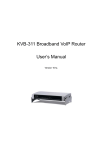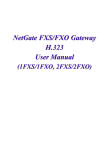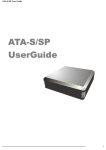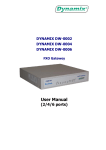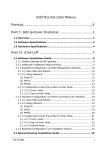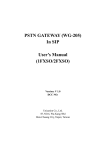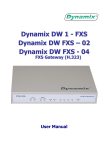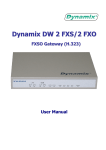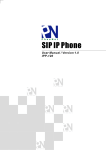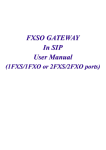Download FXS H.323 Gateway User Manual (2FXS, 2AFXS
Transcript
FXS H.323 Gateway User Manual Version 2.03A September 2003 FXS H.323 Gateway User Manual Notice © Copyright 2002 Co., Ltd. All intellectual property rights in this publication are owned by Co., Ltd. and are protected by Republic of China copyright laws, other applicable copyright laws and international treaty provisions. Co., Ltd. retains all rights not expressly granted. No part of this publication may be reproduced in any form whatsoever or used to make any derivative work without prior written approval by Co., Ltd. No representation of warranties for fitness for any purpose other than what is specifically mentioned in this guide is made either by Co., Ltd. or its agents. Co., Ltd. reserves the right to revise this publication and make changes without obligation to notify any person of such revisions or changes. Co., Ltd. may make improvements or changes in the product(s) and/or the program(s) described in this documentation at any time. If there is any software on removable media described in this publication, it is furnished under a license agreement included with the product as a separate document. If you are unable to locate a copy, please contact Co., Ltd. and a copy will be provided to you. Unless otherwise indicated, Co., Ltd. registered trademarks are registered in the Republic of China and other territories. For further information, contact us or your local distributor or reseller. Note I FXS H.323 Gateway User Manual RELEASE NOTE: Version Date Author Modified Contents 1.3 Nov. 21st, 2001 Burt C.F. Lien 1st RELEASE 1.4 Apr. 10th ,2002 Jerry Kao 1st REVISION 1.6 Aug. 13th ,2002 Jerry Kao 2nd Revision (There is no ver. 1.5):re-organize article structure 2.0 Nov. 05th ,2002 Jerry Kao 3rd Revision: for ver. 200 – added h.450 function & application; web; pppoe 2.0a Dec. 12th ,2002 Jerry Kao Revisied for ver. 200 – added HTTB web user manual 2.1 Mar., Max Su add userdefine in P2P ; codec ; T38 ECM ; h 21 ,2003 2.2 Note Sep, 18th, 2003 Filter ; Ring back tone ; DNS ; RAS and Signal port change ; GK Id ; GK discovery ; Version Id ; FAX redundancy support. Shu-Hui Chen add user define in DDNS; Pt(Payload type). II FXS H.323 Gateway User Manual Table of Contents TABLE OF CONTENTS ................................................................................................................. III LIST OF FIGURES ........................................................................................................................ VI LIST OF TABLE .........................................................................................................................VIII PREFACE .................................................................................................................................... IX FXS GATEWAY OVERVIEW ..................................................................................10 CHAPTER 1 FXS GATEWAY OVERVIEW ..................................................................................... 1-1 1.1 FXS Gateway Overview................................................................................................. 1-1 1.2 Features of The FXS Gateway ....................................................................................... 1-1 1.3 Default Settings.............................................................................................................. 1-2 1.4 Front Panels .................................................................................................................. 1-3 1.5 Back Panel Ports ........................................................................................................... 1-3 1.6 Hardware Specifications................................................................................................ 1-3 1.7 Additional Installation Requirements ............................................................................ 1-7 1.8 Power Up Your FXS Gateway........................................................................................ 1-8 WEB CONFIGURATION WITH FXS GATEWAY....................................10 CHAPTER 2 WEB CONFIGURATION WITH FXS INTRODUCTION .................................................. 2-1 2.1 Web Configuration with FXS Overview......................................................................... 2-1 2.2 Accessing the Web Configuration .................................................................................. 2-1 2.3 Login and welcome screen............................................................................................. 2-1 2.4 Welcome Screen ............................................................................................................. 2-2 2.5 Saving Your Configuration ............................................................................................ 2-3 2.6 Navigating the Web Configurator.................................................................................. 2-4 CHAPTER 3 INITIAL CONFIGURATION ........................................................................................ 3-1 3.1 Initial Configuration Overview ..................................................................................... 3-1 3.2 General Configuration .................................................................................................. 3-1 3.3 Static IP address ............................................................................................................ 3-1 3.4 DHCP mode................................................................................................................... 3-3 3.5 PPPoE mode.................................................................................................................. 3-4 3.6 IP Sharing Configuration .............................................................................................. 3-5 CHAPTER 4 MAKING A VOIP CALL ........................................................................................... 4-1 4.1 Configure the gateway into the Peer-to-Peer mode ...................................................... 4-1 4.2 Configure the gateway into the GK routed mode .......................................................... 4-3 Table of Connect III FXS H.323 Gateway User Manual CHAPTER 5 UPGRADE ROM VERSION ...................................................................................... 5-1 5.1 Before you start downloading....................................................................................... 5-1 5.2 Update Application Version ........................................................................................... 5-1 CHAPTER 6 NETWORK INTERFACE SCREEN............................................................................... 6-1 6.1 Network Interface Overview.......................................................................................... 6-1 6.2 Network Interface Screen............................................................................................... 6-1 CHAPTER 7 H323 INFORMATION SCREEN.................................................................................. 7-1 7.1 H323 Configuration Overview ...................................................................................... 7-1 7.2 H323 Configuration Screen ........................................................................................... 7-1 CHAPTER 8 SYSTEM CONFIGURATION SCREEN ......................................................................... 8-1 8.1 System Configuration Overview .................................................................................... 8-1 8.2 System Configuration Screen......................................................................................... 8-1 CHAPTER 9 VOICE SETTING SCREEN ......................................................................................... 9-1 9.1 Voice Configuration Overview....................................................................................... 9-1 9.2 Voice Configuration Screen ........................................................................................... 9-1 CHAPTER 10 PHONE PATTERN SCREEN ................................................................................... 10-1 10.1 Phone Configuration Overview ................................................................................. 10-1 10.2 Phone Configuration Screen...................................................................................... 10-1 CHAPTER 11 SUPPORT FUNCTION SCREEN .............................................................................. 11-1 11.1 Support Configuration Overview............................................................................... 11-1 11.2 Support Configuration Screen ................................................................................... 11-1 CHAPTER 12 PHONE BOOK SCREEN ........................................................................................ 12-1 12.1 Phone Book Overview ............................................................................................... 12-1 12.2 Phone Book Screen .................................................................................................... 12-1 CHAPTER 13 HOT LINES SCREEN ............................................................................................ 13-1 13.1 Bureau Overview ....................................................................................................... 13-1 13.2 Bureau Screen............................................................................................................ 13-1 CHAPTER 14 SPEED DIAL SCREEN .......................................................................................... 14-1 14.1 Speed Dialing Overview ............................................................................................ 14-1 14.2 Speed Dialing Screen................................................................................................. 14-1 CHAPTER 15 PPPOE CONFIGURATION SCREEN ....................................................................... 15-1 15.1 PPPoE Device Configuration Overview ................................................................... 15-1 15.2 PPPoE Device Configuration Screen ........................................................................ 15-1 CHAPTER 16 IP PACKET TOS SCREEN ..................................................................................... 16-1 16.1 TOS Configuration Overview .................................................................................... 16-1 16.2 TOS Configuration Screen......................................................................................... 16-1 CHAPTER 17 LINE STATUS SCREEN ......................................................................................... 17-1 17.1 Line Status Information Overview ............................................................................. 17-1 Table of Connect IV FXS H.323 Gateway User Manual 17.2 Line Status Screen...................................................................................................... 17-1 CHAPTER 18 VERSION AND INFORMATION SCREEN ................................................................. 18-1 18.1 Version and Information Overview............................................................................ 18-1 18.2 Version and Information Screen ................................................................................ 18-1 CHAPTER 19 PASSWORD SCREEN ............................................................................................ 19-1 19.1 Password Configuration Overview............................................................................ 19-1 19.2 Password Configuration Screen ................................................................................ 19-1 CHAPTER 20 ROM UPGRADE SCREEN .................................................................................... 20-1 20.1 ROM Configuration Overview................................................................................... 20-1 20.2 ROM Configuration Screen ....................................................................................... 20-1 CHAPTER 21 FLASH CLEAN SCREEN ....................................................................................... 21-1 21.1 Flash Clean Overview ............................................................................................... 21-1 21.2 Flash Clean Screen.................................................................................................... 21-1 CHAPTER 22 COMMIT DATA SCREEN ...................................................................................... 22-1 22.1 Commit Configuration Data Overview...................................................................... 22-1 22.2 Commit Configuration Data Screen .......................................................................... 22-1 CHAPTER 23 REBOOT DATA SCREEN ....................................................................................... 23-1 23.1 Reboot FXS Gateway Overview................................................................................. 23-1 23.2 Reboot FXS Gateway Screen ..................................................................................... 23-1 COMMAND WITH FXS GATEWAY ....................................................................2 CHAPTER 24 COMMAND LIST ................................................................................................. 24-1 24.1 Hyper Terminal Setting.............................................................................................. 24-1 24.2 Power Up Your FXS Gateway.................................................................................... 24-3 24.3 Command Structure with FXS Gateway .................................................................... 24-5 24.4 Application modes ..................................................................................................... 24-6 24.5 How to upgrade ....................................................................................................... 24-11 24.6 Commands with FXS Gateway ................................................................................ 24-13 24.7 System Commands Overview................................................................................... 24-14 Table of Connect V FXS H.323 Gateway User Manual List of Figures Figure 1-1 2FXS Front Panel..................................................... 錯誤! 尚未定義書籤。 Figure 1-2 2AFXS Front Panel.................................................................................... 1-3 Figure 1-3 4AFXS Front Panel.................................................................................... 1-3 Figure 1-4 2FXS Gateway Back Panel Ports............................. 錯誤! 尚未定義書籤。 Figure 1-5 2AFXS Gateway Back Panel Ports............................................................ 1-3 Figure 1-6 4AFXS Gateway Back Panel Ports............................................................ 1-3 Figure 2-1 Login Screen .............................................................................................. 2-1 Figure 2-2 FXS Gateway web configuration welcome screen .................................... 2-2 Figure 2-3 Network Interface Screen .......................................................................... 2-4 Figure 3-1 Network Interface ...................................................................................... 3-2 Figure 3-2 Commit Configuration Data ...................................................................... 3-2 Figure 3-3 Reboot FXS Gateway ................................................................................ 3-2 Figure 3-4 Network Interface ...................................................................................... 3-3 Figure 3-5 PPPoE Device Configuration..................................................................... 3-4 Figure 3-6 Enable the IP sharing function ................................................................... 3-6 Figure 4-1 H323 Configuration – Peer to Peer mode Screen ...................................... 4-1 Figure 4-2 Phone Book................................................................................................ 4-2 Figure 4-3 Phone Book – New Record........................................................................ 4-2 Figure 4-4 Phone Book................................................................................................ 4-3 Figure 4-5 Configure the GK info ............................................................................... 4-4 Figure 5-1 ROM Configuration................................................................................... 5-1 Figure 5-2 ROM File Upgrade ok ............................................................................... 5-2 Figure 5-3 Flash Clean ................................................................................................ 5-2 Figure 6-1 Network Interface ...................................................................................... 6-1 Figure 7-1 H323 Configuration ................................................................................... 7-1 Figure 8-1 System Configuration ................................................................................ 8-1 Figure 9-1 Voice Configuration ................................................................................... 9-1 Figure 10-1 Phone Configuration .............................................................................. 10-1 Figure 11-1 Support Configuration............................................................................ 11-1 Figure 12-1 Phone Book............................................................................................ 12-1 Figure 13-1 Bureau.................................................................................................... 13-1 Figure 14-1 Speed Dialing List ................................................................................. 14-1 Figure 15-1 PPPoE Device Configuration................................................................. 15-1 Figure 16-1 TOS Configuration................................................................................. 16-1 Figure 17-1 Line Status Information ......................................................................... 17-1 Figure 18-1 Version and Information ........................................................................ 18-1 Figure 19-1 Password Configuration......................................................................... 19-1 List of Figure VI FXS H.323 Gateway User Manual Figure 20-1 ROM Configuration............................................................................... 20-1 Figure 21-1 Flash Clean ............................................................................................ 21-1 Figure 22-1 Commit Configuration Data .................................................................. 22-1 Figure 23-1 Reboot FXS Gateway ............................................................................ 23-1 Figure 24-1 Connection Description ......................................................................... 24-1 Figure 24-2 Connection Description ......................................................................... 24-2 Figure 24-3 Connect To ............................................................................................. 24-2 Figure 24-4 Com Properties ...................................................................................... 24-3 Figure 24-5 Initial Screen .......................................................................................... 24-4 Figure 24-6 Login Screen .......................................................................................... 24-4 Figure 24-7 Change password Screen ....................................................................... 24-5 Figure 24-8 Quit Commend List ............................................................................. 24-14 Figure 24-9 Debug Commend List .......................................................................... 24-15 Figure 24-10 Reboot Commend List ....................................................................... 24-16 Figure 24-11 Flash Commend List .......................................................................... 24-16 Figure 24-12 Commit Commend List ..................................................................... 24-17 Figure 24-13 Ifaddr Commend List......................................................................... 24-18 Figure 24-14 Time Commend List .......................................................................... 24-19 Figure 24-15 Ping Commend List ........................................................................... 24-19 Figure 24-16 Phone Book Commend List ............................................................... 24-20 Figure 24-17 PPPoE Commend List ....................................................................... 24-21 Figure 24-18 DDNS Commend List........................................................................ 24-22 Figure 24-19 System Information Commend List................................................... 24-24 Figure 24-20 H323 Stack Commend List................................................................ 24-26 Figure 24-21 RTP Commend List............................................................................ 24-28 Figure 24-22 System Information Commend List................................................... 24-29 Figure 24-23 Prefix Commend List......................................................................... 24-29 Figure 24-24 Voice Commend List.......................................................................... 24-31 Figure 24-25 Support Commend List ...................................................................... 24-32 Figure 24-26 ToS Commend List ............................................................................ 24-33 Figure 24-27 Phone Commend List......................................................................... 24-35 Figure 24-28 Bureau Commend List ....................................................................... 24-36 Figure 24-29 rom Commend List ............................................................................ 24-37 Figure 24-30 Passwd Commend List....................................................................... 24-38 Figure 24-31 Speed Dial Commend List................................................................. 24-39 List of Figure VII FXS H.323 Gateway User Manual List of Table Table 1-1 2FXS LEDs Descriptions .......................................... 錯誤! 尚未定義書籤。 Table 1-2 2AFXS LEDs Functions.............................................................................. 1-3 Table 1-3 LEDs Functions ........................................................................................... 1-4 Table 2-1 Navigation Panel Links ............................................................................... 2-2 Table 6-1 H323 Configuration..................................................................................... 6-1 Table 7-1 H323 Configuration..................................................................................... 7-1 Table 8-1 System Configuration.................................................................................. 8-1 Table 9-1 Voice Configuration..................................................................................... 9-1 Table 10-1 Phone Configuration................................................................................ 10-1 Table 11-1 Support Configuration ............................................................................. 11-1 Table 12-1 Phone Book ............................................................................................. 12-1 Table 13-1 Bureau...................................................................................................... 13-1 Table 14-1 Speed Dialing List ................................................................................... 14-1 Table 15-1 PPPoE Device Configuration .................................................................. 15-1 Table 16-1 TOS Configuration .................................................................................. 16-1 Table 17-1 Line Status Information ........................................................................... 17-1 Table 18-1 Version and Information .......................................................................... 18-1 Table 19-1 Password.................................................................................................. 19-1 Table 20-1 ROM Configuration................................................................................. 20-1 Table 21-1 Flash Clean .............................................................................................. 21-1 Table 22-1 Reboot FXS Gateway .............................................................................. 22-1 Table 23-1 Reboot FXS Gateway .............................................................................. 23-1 Table 24-1 Commands with FXS Gateway ............................................................. 24-13 List of Table VIII FXS H.323 Gateway User Manual Preface Congratulations on your purchase of the FXS Gateway. About this User’s Manual This user’s guide gives hardware specifications and explains web configurator and command line configuration for the FXS Gateway. Online Upgrade Please refer to online Technical Support or Select Product VoIP Gateway download library for additional support documentation. General Syntax Conventions ¾ ¾ ¾ ¾ ¾ ¾ Mouse action sequences are denoted using a comma. For example, click start, Settings, Control Panel, Network means first you click Start, Click or move the mouse pointer over Settings the click or move the mouse pointer over Control Panel and finally click (or double-click) Network. “Enter” means for your to type one or more characters. Predefined choices are in Bold Arial Font. Button and field labels, link s and screen names in are in Bold Times New Roman font. A single keystroke is in Arial font and enclosed in square brackets. [Enter] means the Enter. For brevity’s sake, we will use “e.g.,” as shorthand for “for instance”, and “i.e.,” for “that is” or “in other words.” Naming Conventions ¾ “FXS Gateway” refers to the FXS Gateway 2AFXS and 4AFXS for 2 Ethernet Port. Related Documentation ¾ ¾ This user’s guide provides hardware connection details and configuration and management instruction for the managements FXS Gateway. Please refer to Technical Support or Select Product VoIP Gateway download library for additional support documentation. List of Table IX FXS Gateway Overview : Part I: FXS Gateway Overview This part introduces the general features default settings and hardware of the FXS Gateway. I FXS Gateway Overview Chapter 1 FXS Gateway Overview The chapter introduces the FXS Gateway general feature, factory default settings and hardware. 1.1 FXS Gateway Overview FXS Gateway, which based on ITU-T H.323 v3, provides voice and fax over IP networks. Its simplified operation and configuration features are the most suitable for residential and SOHO application. There are three models for FXS Gateway, which are 2FXS, 2AFXS and 4AFXS. One more added switch hub for A series is the only difference. User can choose 2 ports or 4 ports as request in A series. Just an IP address and 2/4 phone sets bring you to Voice over IP world. 1.2 Features of The FXS Gateway FXS Gateway Features z z z z z z z z z z z z z z z z z ITU-T H.323 v3 compliance Ethernet: 2FXS: One 10Base-T Ethernet port 2AFXS / 4AFXS: Two 10/100 Base-T Ethernet ports Configuration interface: RS-232, TELNET and HTTP web management Automatic Gatekeeper Discovery Dimensions: 2FXS: 165(W) x 25(H) x 100mm(D) 2AFXS / 4AFXS: 222(W) x 34(H) x 143mm(D) Transmit Voice and T.38 fax simultaneously Support T.38 ECM function (Error Correction in high speed fax Mode) Provides call progress tone E.164 Common Dial Plan DTMF Dialing Inband/Outband DTMF TFTP/FTP software upgrade Remote configuration/reset LED indication for system status Support Static IP, DHCP and PPPoE To define the dialplan Set the ring back tone from the IP or local FXS Gateway Overview 1-1 FXS Gateway Overview z z z FAX redundancy support RAS and Signal port exchangeable GK id support and GK auto discovery Audio feature z Codec: G.711 a/μlaw, G.723.1 (6.3kbps), G.729A, G.729B, G.729AB z z z z z z z z VAD (Voice Activity Detection) CNG (Comfort Noise Generate) G.168/165-compliant adaptive echo cancellation Dynamic Jitter Buffer Bad Frame Interpolation Voice/DTMF Gain Settings Generate Caller ID (DTMF or FSK) Provide In-band or Out-band DTMF generation/detection z Provide Progress tone System Monitoring z System status (Link, Ready, Status, TEL, Power). Remote Firmware Upgrade You can use FTP/TFTP to perform configuration backup/restore and firmware upgrade for the FXS Gateway from a remote location. Security z z 1.3 Password protection for system management VLAN Default Settings The following are the settings of the defualt profile z Login: root z Password: Null (default) 1.3.1 z z z 1.3.2 z IP Parameters IP Address = 10.1.1.3 Subnet mask = 255.0.0.0 Default gateway = 10.1.1.254 Telnet and Web Login Password Login = root FXS Gateway Overview 1-2 FXS Gateway Overview z 1.4 Password = Null (default) Front Panels Figure 1-11 2AFXS Front Panel Figure 1-2 4AFXS Front Panel 1.5 Back Panel Ports Figure 1-3 2AFXS Gateway Back Panel Ports Figure 1-4 4AFXS Gateway Back Panel Ports 1.6 Hardware Specifications These are the hardware details of the 2AFXS, 4AFXS. 1.6.1 2AFXS LEDs The following table describes the LED functions: Table 1-1 2AFXS LEDs Functions LEDs Functions Indicator Status Active LAN Link/ACT Description Switch to another device, such as PC Link/ACT Green FXS Gateway Overview Blinking While plugging on the Ethernet cable, it must light on and the flash if some data is being TX/RX. 1-3 FXS Gateway Overview LEDs 10/100M Functions LAN Indicator Status Green Active OFF The Ethernet cable is not connected. Off The 10M LAN is connected. On The 100M LAN is connected. WAN Link/ACT 10/100M Ready Description Uplink to the HUB/Router directly. Link/ACT WAN Ready Green Green Green Blinking While plugging on the Ethernet cable, it must light on and the flash if some data is being TX/RX. OFF The Ethernet cable is not connected. Off The 10M WAN is connected. On The 100M WAN is connected. Slow Blinking The FXS Gateway is in normal mode. Fast Blinking The FXS Gateway is in downloading mode. Status TEL(1-2) Power 1.6.2 Status TEL Power Green Red Green Off The FXS Gateway is in Peer-to-Peer Mode. On The FXS Gateway has successfully registered to Gatekeeper when it is in Gatekeeper mode. Blinking The FXS Gateway is not registered to Gatekeeper when it is in Gatekeeper mode. The FXS Gateway is in downloading mode. On The Telephone is Off-Hook. Off The Telephone is On-Hook. On The Power adapter is connected to the Gateway. Off The system is off or not receiving power. 4AFXS LEDs Table 1-2 LEDs Functions LEDs Functions FXS Gateway Overview Indicator Status Active Description 1-4 FXS Gateway Overview LEDs Functions Indicator Status Active LAN Link/ACT 10/100M Switch to another device, such as PC Link/ACT LAN Green Green Blinking While plugging on the Ethernet cable, it must light on and the flash if some data is being TX/RX. OFF The Ethernet cable is not connected. Off The 10M LAN is connected. On The 100M LANis connected. WAN Link/ACT 10/100M Ready Description Uplink to the HUB/Router directly. Link/ACT WAN Ready Green Green Green Blinking While plugging on the Ethernet cable, it must light on and the flash if some data is being TX/RX. OFF The Ethernet cable is not connected. Off The 10M WAN is connected. On The 100M WAN is connected. Slow Blinking The FXS Gateway is in normal mode. Fast Blinking The FXS Gateway is in downloading mode. Status TEL(1-4) Power Status TEL Power Green Red Green FXS Gateway Overview Off The FXS Gateway is in Peer-to-Peer Mode. On The FXS Gateway has successfully registered to Gatekeeper when it is in Gatekeeper mode. Blinking The FXS Gateway is not registered to Gatekeeper when it is in Gatekeeper mode. The FXS Gateway is in downloading mode. On The Telephone is Off-Hook. Off The Telephone is On-Hook. On The Power adapter is connected to the Gateway. Off The system is off or not receiving power. 1-5 FXS Gateway Overview 1.6.3 Back Panel Port Ethernet Port: Ethernet port is for connecting FXS Gateway to network, transmit rate supports 10/100 Base-T. Ethernet connector(LAN) COM Port: RS232 console port (DB-9pin male connector) Note: use straightforward cable to connect to your computer. PINOUTS Pin Name Dir Description 2 RXD Receive Data 3 TXD Transmit Data 5 GND System Ground TEL Port: RJ-11 connector, FXS interface. To connect analog phone sets or trunk line of PABX. 12V DC Port: DC Power supply. FXS Gateway Overview 1-6 FXS Gateway Overview 1.6.4 Back Panel Connections This section outlines how to connect your FXS Gateway to the LAN and the WAN. In the case of connecting a Cable Modem you must connect the coaxial cable from your cable service to the threaded coaxial cable connect on the back of the cable modem. Step 1. Connecting the Console Port For the initial configuration of your FXS Gateway, you need to use terminal emulator software on a workstation and connect it to the FXS Gateway the console port. Connect the 9-pin end of the console cable to the console port of the FXS Gateway and the other end to a serial port (COM1, COM2 or other COM port) of your workstation. You can use an extension RS-232 cable if the enclosed one is too short. After the initial setup, you can modify the configuration remotely through telnet connections. Step 2. Connect the FXS Gateway to the WAN port Connect the WAN port (silver) on the FXS Gateway to the Ethernet port on the cable modem using the cable that came with your cable modem. The Ethernet port on the cable modem is sometimes labeled “PC” or “Workstation”. Step 3. Connecting the PC to the LAN If you have more than one PC, you must use an external hub. Connect the 10/100M LAN Port (gold) on the FXS Gateway to a port on the hub using a straight through Ethernet cable. If you only have one PC, you can connect the FXS Gateway to the PC directly without a hub. For a single PC, connect the 10/100M LAN port on the FXS Gateway to the Network Adapter on the PC using a crossover cable (red tag). Step 4. Connecting the Power Adapter to your FXS Gateway Connect the power adapter to the port labeled POWER on the rear panel FXS Gateway. Caution: To prevent damage to the FXS Gateway, first make sure you have the correct AC power adapter. Please see the Appendices for AC power adapter specifications for your region. Step 5. Grounding the FXS Gateway If you want to ground the FXS Gateway then connect a grounded wire to the F.G. (Frame Ground) of the FXS Gateway. 1.7 Additional Installation Requirements In addition to the contents of your package, there are other hardware and software requirements you need before you can install and use your FXS Gateway. These requirements FXS Gateway Overview 1-7 FXS Gateway Overview include: 1. A computer with an Ethernet NIC (Network Interface Card) installed. 2. A computer equipped with communications software configured to the following parameters: VT100 terminal emulation. 9600 Baud. No parity, 8 Data bits, 1 stop bit, Flow Control set to None. 3. Use Internet Explorer 5.5 and later or Netscape Navigator 6 and later versions. 4. Analog telephone set 5. Software tools: Gatekeeper (optional) After the FXS Gateway is properly set up, you can make future changes to the configuration through telnet connections 1.8 Setting Up the TCP/IP Protocol If you are not sure whether the TCP/IP Protocol has been installed, follow these setups to check, and if necessary, install TCP/IP onto your PCs. Step 1. Click the “Start” button, Choose “Settings”, then “Control Panel”. Double-click the “Network” icon. Your Network window should appear as follows. Step 2. Select the “Configuration” tab. Import: For Windows 2000 & Windows XP Setting, you will find that they differs with Windows 98/ME/NT slightly. See the Following for reference. Click the “Local Area Connection” icon on the lower right hand side of your desktop screen. In the “Local Area Connection Status” windows, click the “Properties” button the your Network windows will appear. There is only one tab, “General”, in the Network window. Step 3. Click whether the TCP/IP Protocol has already been installed onto your computer’s Ethernet card. Note that TCP/IP Protocol an be installed for a computer’s Dial-Up Adapter as well as for the Ethernet cad. - If yes, go to set 7. - If no, click the “Add” button Step 4. Double-click “Protocol” in the Select Network Component Type or highlight “Protocol” then click “Add”. Step 5. Step 6. Highlight “Microsoft” under the list of manufactures After a new second, you will be returned to the Network window. The TCP/IP FXS Gateway Overview 1-8 FXS Gateway Overview Protocol should now be on the list of installed network components. Step 7. Click the “Properties” button. The TCP/IP Properties windows consist of several tabs. Choose the “IP Address” tab. Step 8. Select “Specify an IP Address” and enter “10.1.1.1” in the “IP Address” location (where xxx is a number between 2 and 254 used by the FXS Gateway to identify each computer), and the default “Subnet Mask ”255.0.0.0”. Note than no two computers on the same LAN can have the same IP address. Step 9. Click on the “DNS Configuration” tab and select “Enable DNS”. Then click the “Add” button. Step 10. Click on the “Gateway” tab and enter the High-Performance FXS Gateway default gateway value 10.1.1.254 in the “new gateway” field, then click “Add” Button. Step 11. Click “OK”, Restart your PC to complete the TCP/IP installation. 1.9 Power Up Your FXS Gateway At this point, you should have connected the console port, the LAN Port, the WAN port and the power port to the appropriate devices or lines. Plug the power adapter into a wall outlet. The Power LED should be on. The Status LED will come on after the system tests are complete. The WAN LED and one of the LAN LEDs come on immediately after the Status LED come on, if connections have been made to the LAN and WAN ports. FXS Gateway Overview 1-9 FXS Gateway Overview : Part II: Web Configuration with FXS Gateway This part tells how to access and navigate the web configurator and perform initial configuration. It also describes the Getting Started web configuration when you use the FXS Gateway. II FXS Gateway Overview Chapter 2 Web Configuration with FXS Introduction This Chapter describes how to login into the WEB and navigate through it. 2.1 Web Configuration with FXS Overview The embedded web configuration allows you to use a web browser to manage the FXS Gateway. 2.2 Accessing the Web Configuration You will need a computer with and Ethernet 10BaseT, 100Base-TX Network Interface Card (NIC). Connect to the LAN port in the FXS. Use Internet Explorer 5.5 and later or Netscape Navigator 6 and later versions. Use the following instructions to login on to the web configuration. 2.3 Login and welcome screen Step 1. Step 2. Start your web browser. Launch your web browser and enter “10.1.1.3” (the default IP address of the FXS Gateway) in the Location or Address field. Press Enter. Step 3. The Password screen now appears. Type “root” in the user name field (it may display automatically for you) and your password (default “Null”) in the password field. Step 4. Click OK. Step 5. Figure 2-1 Login Screen After a successful login, you will see the welcome screen show next. Web Configuration with FXS Introduction 2-1 FXS Gateway Overview 2.4 Welcome Screen This is the web configuration welcome screen. Click a link on the navigation panel to go to the corresponding screen. Figure 2-2 FXS Gateway web configuration welcome screen The following table describes the screen. Table 2-1 Navigation Panel Links LABEL Network Interface DESCRIPTION This link takes you to a screen where you can configure the FXS Gateway Network Interface Information. H323 Information This link takes you to a screen where you can setup up H323 Information. System Config This link takes you to a screen where you can set up System Configuration. Voice Setting This link takes you to a screen where you can set up Voice Configuration. Phone Pattern This link takes you to a screen where you can set up Phone Pattern Configuration. Web Configuration with FXS Introduction 2-2 FXS Gateway Overview LABEL Support Functions DESCRIPTION This link takes you to a screen where you can set up Support Functions Configuration. Phone Book This link takes you to a screen where you can set up Phone Book Information. Hot Lines This link takes you to a screen where you can set up Hot Lines configuration. Speed Dial This link takes you to a screen where you can set up Speed Dialing List. PPPoE Configuration This link takes you to a screen where you can set up PPPoE Device Configuration. IP Packet ToS This link takes you to a screen where you can set up TOS Configuration. Line Status This link takes you to a screen where you can view Line information about the status of the FXS Gateway. Version and This link takes you to a screen where you can view Version and Information Information of the FXS Gateway. Password This link takes you to a screen where you can change passwords. ROM Upgrade This link takes you to a screen where you can change ROM Upgrade configuration. Flash Clean This link takes you to a screen where you can click flash memory information and configuration. Commit Data This link takes you to a screen where you can click save your changes to the non-volatile memory. Reboot System This link takes you to a screen where you can click to reboot FXS Gateway. 2.5 Saving Your Configuration Click OK to save your changes back to the FXS Gateway volatile memory. The FXS Gateway loses these changes if it is turned off or loses power, so use the Commit Data link on the navigation panel to the left to save your changes to the non-volatile memory when your are done configuring. Web Configuration with FXS Introduction 2-3 FXS Gateway Overview 2.6 Navigating the Web Configurator The web configurator uses one level. For example, to configure Network Interface, click the link on the navigation panel to open the configuration screen. Figure 2-3 Network Interface Screen Web Configuration with FXS Introduction 2-4 FXS Gateway Overview Chapter 3 Initial Configuration This Chapter covers the basic configuration needed to set up and use the FXS Gateway. Refer to the other part describes about individual fields within screens. 3.1 Initial Configuration Overview This chapter describes the procedure for the initial configuration of the FXS Gateway. Refer to the relevant chapters in this User’s Guide for descriptions of the fields and buttons within individual screens. 3.2 General Configuration The FXS Gateway the factory with a default IP address of 10.1.1.3 and a subnet mask of 255.0.0.0. 3.3 Step 1. Static IP address Configuration the FXS Gateway IP address. Click Network Interface on the navigation panel. In the Network Interface screen, type a new IP address, subnet mask and the default routing gateway (e.g. IP Address: 192.168.4.92, Subnet mask: 255.255.0.0, Default routing gateway: 192.168.1.254) and click the OK button. Initial Configuration 3-1 FXS Gateway Overview Figure 3-1 Network Interface Step 2. Click Commit Data on the navigation panel. In the Commit Configuration Data screen, click the Commit button. In the Commit Configuration Data screen to Display Commit to Flash OK!, When the Commit Data Ok. Figure 3-2 Commit Configuration Data Step 3. Click Reboot Data on the navigation panel. In the Reboot FXS Gateway screen, click the Reboot button. It will take 40 seconds to reboot. Figure 3-3 Reboot FXS Gateway Step 4. Close the current browser windows and launch your web browser again. Enter the new IP address in the Location or Address field. Press [Enter]. Initial Configuration 3-2 FXS Gateway Overview 3.4 Step 1. DHCP mode Configuration the FXS Gateway IP address for DHCP Mode. Click Network Interface on the navigation panel. In the Network Interface screen, enable the DHCP function if you are using the cable modem or DHCP server and click the OK button. Figure 3-4 Network Interface Step 2. Click Commit Data on the navigation panel. In the Commit Configuration Data screen, click the Commit button. In the Commit Configuration Data screen to Display Commit to Flash OK!, When the Commit Data Ok. Step 3. Click Reboot Data on the navigation panel. In the Reboot FXS Gateway screen, click the Reboot button. It will take 40 seconds to reboot. Step 4. Close the current browser windows and launch your web browser again. Enter the new IP address in the Location or Address field. Press [Enter]. Initial Configuration 3-3 FXS Gateway Overview 3.5 PPPoE mode ATU-R ADSL Modem ID Password FXS Gateway Step 1. Configuration the FXS Gateway IP address for PPPoE Mode. Click PPPoE Configuration on the navigation panel. In the PPPoE Configuration screen, On the Device and put the info of the PPPoE User Name and password (e.g. User: [email protected], password: 123456) and click the OK button. Figure 3-5 PPPoE Device Configuration Step 2. Click Commit Data on the navigation panel. In the Commit Configuration Data screen, click the Commit button. In the Commit Configuration Data screen to Display Commit to Flash OK!, When the Commit Data Ok. Step 3. Click Reboot Data on the navigation panel. In the Reboot FXS Gateway screen, click the Reboot button. It will take 40 seconds to reboot. Step 4. Close the current browser windows and launch your web browser again. Enter the new IP address in the Location or Address field. Press [Enter]. Initial Configuration 3-4 FXS Gateway Overview 3.6 IP Sharing Configuration The function is only for the user who is using the IP Sharing device. It is said Gateway is connected to the IP Sharing device. The IP Sharing Device must support the DMZ or Virtual server functions An e.g. such as ADSL network is in the following. ATU-R ADSL Modem WAN ① IP Sharing device⑤ LAN ② LAN③ Gateway ④ 1. 2. 3. 4. PC The WAN IP Address obtained from ADSL has two kinds of methods. One is fixed IP Address, while user applies for one or more fixed IP Addresses. Another is dynamic IP Address while user applies for dial-up connection way. The LAN IP Address of User’s PC can be set as DHCP client in order to gain a valid one. Another IP Address for Gateway must be set as an fixed one in order for that IP Sharing device pass forwarding the relevant information from WAN to LAN. Besides, a valid IP Address meets the IP Sharing device (LAN site) is the element. FXS Gateway must enable the IP Sharing function for the fixed/dynamic WAN IP Address. Please be noted With Dynamic WAN IP Address, a valid Gatekeeper for FXS Gateway to get register on is a must. In other word, it is not workable in Peer-to-Peer mode while dynamic WAN IP Address. 5. IP Sharing device must have a function to do IP/Port mapping. Some is named as DMZ, some is named as virtual server whatever. The VoIP messages from WAN have to completely pass forward to the LAN. It is said if the FXS Gateway is assigned a virtual fixed IP Address such as 192.168.1.5, IP Sharing device must forward the VoIP message to 192.168.1.5. Initial Configuration 3-5 FXS Gateway Overview Step 1. Configuration the FXS Gateway IP address for IP Sharing Mode. Click Network Interface on the navigation panel. In the Network Interface screen, enter the IP address, Subnet mask and the default gateway in the network table. Please follow up your IP Sharing device Step 2. Enable the IP sharing function and put the static IP address in the IP Sharing server address (e.g. 192.168.4.96) and click the OK button. Figure 3-6 Enable the IP sharing function Step 3. Click Commit Data on the navigation panel. In the Commit Configuration Data screen, click the Commit button. In the Commit Configuration Data screen to Display Commit to Flash OK!, When the Commit Data Ok. Step 4. Click Reboot Data on the navigation panel. In the Reboot FXS Gateway screen, click the Reboot button. It will take 40 seconds to reboot. Step 5. Close the current browser windows and launch your web browser again. Enter the new IP address in the Location or Address field. Press [Enter]. Initial Configuration 3-6 FXS Gateway Overview Chapter 4 Making a VoIP Call This Chapter covers the basic configuration the gateway for making VoIP calls. One is the Peer-to-Peer mode, another is GK routed mode. The configurations and functions are different. Please make sure about the mode you want and follow up the step to configure your gateway. 4.1 Step 1. Configure the gateway into the Peer-to-Peer mode Configuration the FXS Gateway H323 Configuration. Click H323 Configuration on the navigation panel. In the H323 Configuration screen, select Peer-to-Peer Mode function, set line number (e.g. Line1 Number 000, Line2 Number: 001) and click the OK button. Figure 4-1 H323 Configuration – Peer to Peer mode Screen Step 2. Configuration the FXS Gateway Phone Book. Click Phone Book on the navigation panel. In the Phone Book screen, enter the Index, Name, IP address and e164 (phone number) of the destination and click the Add Data button. Making a VoIP Call Screen 4-1 FXS Gateway Overview Step 3. Figure 4-2 Phone Book E.g. enter the Index: 1, Name: test1, IP address: 192.168.4.72 and e164 No.: 20 of the destination and click the Add Data button. Figure 4-3 Phone Book – New Record Step 4. On table will display on the first index. Making a VoIP Call Screen 4-2 FXS Gateway Overview Figure 4-4 Phone Book Step 5. Click Commit Data on the navigation panel. In the Commit Configuration Data screen, click the Commit button. In the Commit Configuration Data screen to Display Commit to Flash OK!, When the Commit Data Ok. Step 6. Click Reboot Data on the navigation panel. In the Reboot FXS Gateway screen, click the Reboot button. It will take 40 seconds to reboot. 4.2 Configure the gateway into the GK routed mode Step 1. Configuration the FXS Gateway H323 Configuration. Click H323 Configuration on the navigation panel. In the H323 Configuration screen, select GK routed Mode function. Step 2. To change the GK information from your service provider Gatekeeper IP, 2nd Gatekeeper IP, Gateway Type, Registered Prefix, Line1 Number, Line 2 Number (e.g. Gatekeeper IP: 192.168.4.71, 2nd Gatekeeper IP: 192.168.4.71, Gateway Type: Gateway, Registered Prefix:0, Line1 Number: 000, Line2 Number: 001), and click the OK button. Making a VoIP Call Screen 4-3 FXS Gateway Overview Figure 4-5 Configure the GK info Step 3. Click Commit Data on the navigation panel. In the Commit Configuration Data screen, click the Commit button. In the Commit Configuration Data screen to Display Commit to Flash OK!, When the Commit Data Ok. Step 4. Click Reboot Data on the navigation panel. In the Reboot FXS Gateway screen, click the Reboot button. It will take 40 seconds to reboot. Making a VoIP Call Screen 4-4 FXS Gateway Overview Chapter 5 Upgrade ROM Version This Chapter covers the basic how to upgrade FXS Gateway ROM Version. 5.1 1. 2. 3. 4. Before you start downloading TFTP server program is available to obtain from technical support website. Please create one directory for TFTP server program on one local PC, and then execute it. Put the file, which prepared to upgrade in the same directory. Please confirm Host PC, which is installed as TFTP / FTP server and device is in available network. Remember the current configuration, such as [pbook], [h323]. 5.2 Step 1. Update Application Version Update the FXS Gateway ROM Version. Click ROM Upgrade on the navigation panel. In the ROM Configuration screen, type a Server IP address, Target File Name, Method, Target File Type (e.g. Server IP Address: 192.168.4.70, Target File Name: 4afxs.203a, Method: TFTP, Target File Type: Application image) and click the OK button. Figure 5-1 ROM Configuration Step 2. In the screen to Display Please issue FLASH CLEAN to consist software version. When the ROM Upgrade file ok. Upgrade ROM Screen 5-1 FXS Gateway Overview Figure 5-2 ROM File Upgrade ok Step 3. Click Flash Clean on the navigation panel. In the Flash Clean screen, click the CLEAN button. In the Flash Clean screen to Display Flash cleaned!! Please reboot your system!!, When the Flash Clean Ok. Figure 5-3 Flash Clean Step 4. Click Reboot Data on the navigation panel. In the Reboot FXS Gateway screen, click the Reboot button. It will take 40 seconds to reboot. Step 5. Close the current browser windows and launch your web browser again. Enter the IP address in the Location or Address field. Press [Enter]. Upgrade ROM Screen 5-2 FXS Gateway Overview Chapter 6 Network Interface Screen This Chapter covers setup Network Interface identification information for FXS Gateway. 6.1 Network Interface Overview The web configurator provides Network Interface screen. 6.2 Network Interface Screen Click Network Interface in the navigation panel and open the Network Interface Screen. Use this screen to setup Network Interface identification information for the FXS Gateway. Figure 6-1 Network Interface The following table describes this screen. Table 6-1 H323 Configuration LABEL IP Address DESCRIPTION Enter the IP Address of the FXS Gateway in dotted decimal notation for e.g. 192.168.4.92. Range of IP Address setting Network Interface Screen 6-1 FXS Gateway Overview LABEL DESCRIPTION (0.0.0.0~255.255.55.255). Subnet Mask Enter the IP Subnet Mask of your FXS Gateway in dotted decimal notation for e.g. 255.255.0.0. Default Routing Enter the IP Address of the default-outgoing gateway of your FXS Gateway Gateway in dotted decimal notation for e.g. 192.168.1.254. DHCP Select enable/disable Dynamic Host Configuration. HTTP Port Set FXS Gateway HTTP Port Number e.g. 80. DNS primary Enter the DNS IP Address in dotted decimal notation for e.g. 168.95.1.1 DNS Secondary Enter the DNS secondary IP Address in dotted decimal notation for e.g. 168.95.1.1 SNTP Select enable/disable Simple Network Time Protocol. SNTP Server Address Set specify a SNTP Server as network time source in dotted decimal notation for e.g. 168.95.192.12. GMT Set local time zone according to GMT e.g. 8. IP Sharing Select enable IP Sharing function, when you specify usage of and IP Sharing device. IP Sharing Server Enter specify a global fixed IP Address, user can add this IP Address in Address dotted decimal notation for e.g. 210.11.22.33. OK Click OK to save your changes back to the FXS Gateway volatile memory. Network Interface Screen 6-2 FXS Gateway Overview Chapter 7 H323 Information Screen This Chapter covers setup H.323 related parameters. 7.1 H323 Configuration Overview The web configurator provides H.323 Configuration screen. 7.2 H323 Configuration Screen Click H323 Configuration in the navigation panel and open the H323 Configuration Screen. Figure 7-1 H323 Configuration The following table describes this screen. Table 7-1 H323 Configuration LABEL DESCRIPTION Mode Select Gatekeeper routed mode or Peer-to-Peer mode. GateKeeper IP Set Gatekeeper IP Address in dotted decimal notation e.g.192.168.4.71. Address 2nd GateKeeper IP Set redundancy second 2 Gatekeeper IP Address in dotted decimal H323 Information Screen 7-1 FXS Gateway Overview LABEL DESCRIPTION notation e.g.192.168.4.71. Gateway Type Select registration Gateway Type is Gateway mode or Terminal mode. Registered Prefix Set Prefix number while registration Gateway Type is Gateway example 60. Line1 Number Set Line1 number e.g.601. Line2 Number Set Line2 number e.g.602. Line3 Number Set Line3 number e.g.603. Line4 Number Set Line4 number e.g.604. Registered Alias Set IP side Registration alias as h323 ID. Display Information Set string representing display information for repertory to the called party. Multicast Select Gatekeeper auto Discovery is enable/disable. RTP Port Set RTP port number, example 16384. Time To Live (TTL) Set RAS TTL Time, example 60. Gatekeeper finding Set Gatekeeper finding port e.g.1718. port Gatekeeper RAS Port Set Gatekeeper RAS Port e.g.1719. H225 RAS Port Set H225 Call RAS Port e.g.1024. H225 Call Signal Port Set H225 Call Signal Port e.g.1720. Response Timeout Set max waiting time for 1st response to a new call e.g.15. Connection Timeout Set max waiting times for call establishment after receiving 1st response of a new all e.g.200. OK Click OK to save your changes back to the FXS Gateway volatile memory. Note: Line1 & Line2 number must follow the prefix number if device is configured as Gateway type. For example, if prefix number is 999, the line1 & line2 number are 9991 & 9992. H323 Information Screen 7-2 FXS Gateway Overview Chapter 8 System Configuration Screen This Chapter covers System Information and configuration. 8.1 System Configuration Overview The web configurator provides System Configuration screen. 8.2 System Configuration Screen Click System conf in the navigation panel and open the System Configuration Screen. Figure 8-1 System Configuration The following table describes this screen. Table 8-1 System Configuration LABEL Keypad Type DESCRIPTION Select In-Band, H.245 (Alpha), H.245 (Sig), Q931, RFC2833 on DTMF replay type Dial Plan Set Number of digits for dial plan, e.g. 0. Inter Digit Time Set Inter-Digits time e.g. 3. Busy Forward Working in both Gatekeeper mode and Peer-to-Peer mode (some previous version does not support in Peer-to-Peer mode). If the line1 is System Configuration Screen 8-1 FXS Gateway Overview LABEL DESCRIPTION engaged as well as this function is enabled, the line2 will be ringing. Gateway Service Select specify gateway service type: Dial in service or Hot-Line service, default: Dial in service. Call Alive Select on/off for Call Alive function. Prefix Set user defined local zone prefix. Prefix Switch Select on/off for User defined local zone prefix switch. Prefix Disable Digit Disable the defined prefix after press the selected digit (0,1~9, *) OK Click OK to save your changes back to the FXS Gateway volatile memory. System Configuration Screen 8-2 FXS Gateway Overview Chapter 9 Voice Setting Screen This Chapter covers voice is associated with the audio setting information. 9.1 Voice Configuration Overview The web configurator provides Voice Configuration screen. 9.2 Voice Configuration Screen Click Voice Setting in the navigation panel and open the Voice Configuration Screen. Figure 9-1 Voice Configuration The following table describes this screen. Table 9-1 Voice Configuration LABEL Codec Priority DESCRIPTION Set priority preference of installed codes, G.723, G.711A, G.711U, G.729, G.729A, G.729B, G.729AB. Frame Size Set Specify sending packet size, G.723, G.711A, G.711U, G.729, G.729A, G.729B, G.729AB. G723 Silence Select enable/disable for G723 Silence Suppression function. Suppression Volume Set voice, input, DTMF functions specify the following levels. Echo Canceller Setting enable/disable of echo canceller. Voice Setting Screen 9-1 FXS Gateway Overview LABEL Jitter Buffer Min. DESCRIPTION Setting of jitter buffer min delay. Delay Jitter Buffer Max. Setting of jitter buffer max delay. Delay Optimized Factor Setting Optimized Factor (Jitter). (Jitter): OK Click OK to save your changes back to the FXS Gateway volatile memory. Note: Well the application before you change voice parameters, because this might cause incompatibility. Voice Setting Screen 9-2 FXS Gateway Overview Chapter 10 Phone Pattern Screen This Chapter covers FXS Gateway progress tone is configurable. Default tone value is set according to U.S. tone specification. Users may adjust the values according to their own country’s tone specification or users-defined tone specification. 10.1 Phone Configuration Overview The web configurator provides Phone Configuration screen. 10.2 Phone Configuration Screen Click Phone Pattern in the navigation panel and open the Phone Pattern Screen. Figure 10-1 Phone Configuration The following table describes this screen. Table 10-1 Phone Configuration LABEL DESCRIPTION Ring Tone Setting the played tone type, when FXS Gateway is receiving a call. Ring Back Tone Setting the played tone type, when FXS Gateway receives a Q.931 Alerting message. In condition that FXS Gateway is the originate side. Busy Tone Setting the played tone type, when destination is busy. Dial Tone Setting the played tone type, when hook off a phone set of workable FXS Gateway. Phone Patterm Screen 10-1 FXS Gateway Overview LABEL DESCRIPTION 2nd Dial Tone Set the detective flash range in ms, for example, 300-500 ms. OK Click OK to save your changes back to the FXS Gateway volatile memory. Phone Patterm Screen 10-2 FXS Gateway Overview Chapter 11 Support Function Screen This Chapter provides some extra functions that might be needed by users. 11.1 Support Configuration Overview The web configurator provides Support Configuration screen. 11.2 Support Configuration Screen Click Support Function in the navigation panel and open the Support Function Screen. Figure 11-1 Support Configuration The following table describes this screen. Table 11-1 Support Configuration LABEL DESCRIPTION T.38 FAX Select enable/disable for T.38 FAX Function. When T.38 ability is ON, FXS Gateway will automatically defer codec (G.723 or G.729a) to T.38 when FAX signal is detected. T.38 FAX ECM Select enable/disable for T.38 FAX ECM Function. Support the error correction in the high speed fax mode Fast Start Select enable/disable for Fast Start function. Fast Start function can shorten the connection time if the opposite party also supports Fast Start. H.245 Tunneling Select enable/disable for H.245 Tunneling function. If the function is ON, FXS Gateway will send H.245 (Call Control messages) via H.225’s (Call Signal messages) link. The function is effective only when both side support h245 tunnel. Support Function Screen 11-1 FXS Gateway Overview LABEL DESCRIPTION H.245 Message After Select enable/disable for H.245 Message After Fast Start function. If the Fast Start function is ON, FXS Gateway will send H.245 messages after Fast Start. OK Click OK to save your changes back to the FXS Gateway volatile memory. Note: it is not recommended to change the value in this command, only if users do know well the application. This might cause incompatibility with other devices. Support Function Screen 11-2 FXS Gateway Overview Chapter 12 Phone Book Screen This Chapter covers Phone Book function allows users to define their own numbers, which mapping to real IP address. It is effective only in peer-to-peer mode. When adding a record to Phone Book, users do not have to reboot the machine, and the record will be effective immediately. 12.1 Phone Book Overview The web configurator allows you to Set up Phone Book that tell the FXS Gateway how to call management traffic when you configuration P2P mode. 12.2 Phone Book Screen Click Phone Book in the navigation panel and open the phone Book Screen. Figure 12-1 Phone Book The following table describes this screen. Table 12-1 Phone Book LABEL DESCRIPTION Record List Index Phone Book Screen The field displays the index number. 12-1 FXS Gateway Overview LABEL DESCRIPTION Name The field displays the descriptive name. IP Address The field displays the IP Address or Domain name. e164 The field displays the descriptive e164 number. New Record Index Set up an Index number. Name Set up a descriptive name. IP Address Set up IP Address or Domain Name. e164 No. Set up e164 (telephone) number Add Data Add a record to Phone Book. Delete Data Delete a record to Phone Book. Note: The e164 number defined in phone book will fully carry to destination. It is not just a representative number for destination’s IP Address. In other words, user dial this e164 number to reach destination, destination will receive the number and find out if it is matched to its e164, including Line number in some particular device. Phone Book Screen 12-2 FXS Gateway Overview Chapter 13 Hot Lines Screen This Chapter covers to set Hotline function must be under Peer-to-Peer mode and switch to hotline mode. 13.1 Bureau Overview The web configurator provides Bureau screen. 13.2 Bureau Screen Click Hot Line in the navigation panel and open the Bureau Screen. Figure 13-1 Bureau The following table describes this screen. Table 13-1 Bureau LABEL DESCRIPTION Bureau Port The field displays the Port number. Destination Address The field displays the Destination Address. Remote_TEL(FXS) The field displays the Remote TEL number. Port_No(FXO) New Record Port Set up a port number. Destination Address Set up IP Address. Hot Line Screen 13-1 FXS Gateway Overview LABEL DESCRIPTION Remote Number Set up Remote Number. Set Set a record to Bureau. Hot Line Screen 13-2 FXS Gateway Overview Chapter 14 Speed Dial Screen This Chapter covers Speed Dial information and configuration 14.1 Speed Dialing Overview The web configurator provides Speed Dialing screen. 14.2 Speed Dialing Screen Click Speed Dial in the navigation panel and open the Speed Dial List Screen. Figure 14-1 Speed Dialing List The following table describes this screen. Table 14-1 Speed Dialing List LABEL DESCRIPTION Speed Dialing List Brief The field displays the Brief number. Mapping Number The field displays the Mapping Number. Speed Dialing Select enable/disable of Speed Dialing function. Speed Dial Screen 14-1 FXS Gateway Overview LABEL DESCRIPTION Function New Record Brief Set up a Brief number. Mapping Number Set up Mapping number. Add Data Add a record to Speed Dialing. Delete Data Delete a record to Speed Dialing. Speed Dial Screen 14-2 FXS Gateway Overview Chapter 15 PPPoE Configuration Screen This Chapter covers Display PPPoE related information. 15.1 PPPoE Device Configuration Overview The web configurator provides PPPoE Device Configuration screen. 15.2 PPPoE Device Configuration Screen Click PPPoE Configuration in the navigation panel and open the PPoE Device Configuration Screen. Figure 15-1 PPPoE Device Configuration The following table describes this screen. Table 15-1 PPPoE Device Configuration LABEL DESCRIPTION Device Select on/off of PPPoE device function. User Name Enter the User Name of PPPoE Login ID. Password Enter the password of PPPoE Login Password. IP Address This filed display the IP Address, when you registration PPPoE success. Destination This filed display the Destination, when you registration PPPoE success. DNS primary This filed display the DNS IP Address, when you registration PPPoE PPPoE Configuration Screen 15-1 FXS Gateway Overview LABEL DESCRIPTION success. Reboot After Remote Select on/off of reboot after remoter host disconnection function. Host Disconnection OK Click OK to save your changes back to the FXS Gateway volatile memory. Note: User’s could insert any information in IP Address, Destination and DNS Primary. PPPoE Configuration Screen 15-2 FXS Gateway Overview Chapter 16 IP Packet ToS Screen This Chapter covers IP Packet ToS (Type of Service)/Differentiated Service configuration. 16.1 TOS Configuration Overview The web configurator provides TOS Configuration screen. 16.2 TOS Configuration Screen Click IP Packet ToS in the navigation panel and open the TOS Configuration Screen. Figure 16-1 TOS Configuration The following table describes this screen. Table 16-1 TOS Configuration LABEL DESCRIPTION Signaling Packet Set the Signaling Packet DSCP code value, the value of is from 0 to 63 DSCP Code e.g.7. Media Packet DSCP Set the Media Packet DSCP Code, the value of is from 0 to 63 e.g.0. Code IP Packet ToS Screen 16-1 FXS Gateway Overview Chapter 17 Line Status Screen This chapter explains the Line Status Information Screen. 17.1 Line Status Information Overview The web configurator provides Line Status Information screen. 17.2 Line Status Screen Click Line Status in the navigation panel to open the Line Status Information screen. Figure 17-1 Line Status Information The following table describes this screen. Table 17-1 Line Status Information LABEL Line (1-4) Line Status Screen DESCRIPTION This field Display line status is Ready or Busy. 17-1 FXS Gateway Overview Chapter 18 Version and Information Screen This chapter explains the Version and Information Screen. 18.1 Version and Information Overview The web configurator provides Version and Information screen to allow you to see FXS Gateway Version Information. 18.2 Version and Information Screen Click Version and Information in the navigation panel to open the Version and Information screen. Figure 18-1 Version and Information The following table describes this screen. Table 18-1 Version and Information LABEL DESCRIPTION Boot Rom This field refers to the Boot Rom Version. Application Rom This field refers to the Application Rom Version. DSP Application This field refers to the DSP Application Version. DSP Kernel This field refers to the DSP Kernel Version. DSP Test Code This field refers to the DSP Test Code Version. Version and Information Screen 18-1 FXS Gateway Overview Chapter 19 Password Screen This Chapter explains how to change the FXS Gateway password. 19.1 Password Configuration Overview The Password screen allows you to configure the administrator password. 19.2 Password Configuration Screen Click Password in the navigation panel to open the Password Configuration screen. Use the Password Configuration to set root and administrator password for the FXS Gateway. It is highly recommended that you change the default password (“Null”). Figure 19-1 Password Configuration The following table describes this screen. Table 19-1 Password LABEL DESCRIPTION Username Select root or administrator different options from the drop-down list box. Current Password Type the existing system password (“Null” is the default password when shipped). New Password Type your new system password. Confirm New Confirm your new system password for confirmation. Password CHANGE Click CHANGE to save your change back to the FXS Gateway volatile memory. ABORT Password Screen Click ABORT to begin configuring this page afresh. 19-1 FXS Gateway Overview Chapter 20 ROM Upgrade Screen This Chapter explains how to Update FXS Gateway Version. 20.1 ROM Configuration Overview The web configurator provides Update FXS Gateway ROM Version. 20.2 ROM Configuration Screen Click ROM Upgrade in the navigation panel and open the ROM Configuration Screen. Figure 20-1 ROM Configuration The following table describes this screen. Table 20-1 ROM Configuration LABEL DESCRIPTION Server IP Address Enter the FTP or TFTP Server IP Address. Target File Name Enter the file name prepared to upgrade. Method Select download method as FTP or TFTP. FTP Login Name Enter the FTP Login name (max 14 byte) FTP Login Password Enter the FTP Login password (max 14 byte) Target File Type Select download Target File Type on 2M Boot Image, DSP Application Image, DSP Core Image, DSP Test Image different options from the drop-down list box. OK Click OK to save your change back to the FXS Gateway volatile memory. ROM Upgrade Screen 20-1 FXS Gateway Overview Chapter 21 Flash Clean Screen This Chapter covers save change and clean all the user defined value in factory default mode. 21.1 Flash Clean Overview The web configurator provides Flash Clean screen. 21.2 Flash Clean Screen Click Flash Clean in the navigation panel and open the Flash Clean Screen. Figure 21-1 Flash Clean The following table describes this screen. Table 21-1 Flash Clean LABEL Clean DESCRIPTION Save Changes after configuring FXS Gateway. Note: It is only executed by user whose login name is root. All configurations in command [ifaddr], [pppoe] will be kept. ROM Upgrade Screen 21-1 FXS Gateway Overview Chapter 22 Commit Data Screen This Chapter covers save change after configuring FXS Gateway. 22.1 Commit Configuration Data Overview The web configurator provides Commit Configuration Data screen. 22.2 Commit Configuration Data Screen Click Commit Data in the navigation panel and open the Commit Configuration Data Screen. Figure 22-1 Commit Configuration Data The following table describes this screen. Table 22-1 Reboot FXS Gateway LABEL Commit DESCRIPTION Save changes after configuring FXS Gateway. Commit Data Screen 22-1 FXS Gateway Overview Chapter 23 Reboot Data Screen This Chapter covers reboot to reload FXS Gateway in new configuration. 23.1 Reboot FXS Gateway Overview The web configurator provides Reboot FXS Gateway screen. 23.2 Reboot FXS Gateway Screen Click Reboot Data in the navigation panel and open the Reboot FXS Gateway Screen. Figure 23-1 Reboot FXS Gateway The following table describes this screen. Table 23-1 Reboot FXS Gateway LABEL Reboot DESCRIPTION After commit command, type reboot to reload FXS Gateway in new configuration. The procedure is as below: Reboot Data Screen 23-1 Command with FXS Gateway Part III: Command with FXS Gateway This part gives information on commands to use. III Command with FXS Gateway Chapter 24 Command List This section introduces the command line interface and lists all of the commands. 24.1 Hyper Terminal Setting A terminal emulator is needed when using RS-232 port to configure FXS Gateway. There are kinds of terminal emulator software. Here, we use Microsoft HyperTerminal to depict how to set up terminal emulator: Step 1. Step 2. Execute the Hyper Terminal program, and then the following windows will pop-up on the screen. (STARTÆProgram filesÆAccessoriesÆCommunicationÆHyper Terminal) Figure 24-1 Connection Description Define a name such as voip for this new connection. Command List 24-1 Command with FXS Gateway Figure 24-2 Connection Description Step 3. After pressing OK button, the next window appear, and then choose COM1/2 Port, which you are going to use. Figure 24-3 Connect To Step 4. Configure the COM Port Properties as following: Bits per second: 9600, Flow control: None, Press OK button, and then start to configure FXS Gateway. Command List 24-2 Command with FXS Gateway Figure 24-4 Com Properties 24.2 Power Up Your FXS Gateway At this point, you should have connected the console port, the LAN Port, the WAN port and the power port to the appropriate devices or lines. Plug the power adapter into a wall outlet. The Power LED should be on. The Status LED will come on after the system tests are complete. The WAN LED and one of the LAN LEDs come on immediately after the Status LED come on, if connections have been made to the LAN and WAN ports. Initial Screen When you power on your FXS Gateway it performs server internal tests as well as line initialization. After the tests, the FXS Gateway asks you to enter the Login, as shown. Attached TCP/IP interface to cpm unit 0 Attaching interface lo0..done Please wait while system is initializing ..... SAttached TCP/IP interface to cpm unit 0 Attaching interface lo0..done HTTPD initialized.. cmInitialize succeed! Ras port:1024 CallSignal port:1720 Command List 24-3 Command with FXS Gateway GK mode selected. AC4804[0] is ok AC4804[1] is ok successful 2 2 Initialize OSS libraries..OK! VP v1.42 stack open sucessfully. login: Figure 24-5 Initial Screen Entering Login For you first login, enter the login root and default password “Null”. As you type the password, the screen displays and (*) for each character you type. successful 2 2 Initialize OSS libraries..OK! VP v1.42 stack open sucessfully. login:root Welcome to Terminal Configuration Mode Please enter your configuration item usr/config$ Figure 24-6 Login Screen Note: login: root or administrator is the default login name and there is no password needed. Set Password To set your own password in root login name, just input command “passwd –set root ****”. For example, if password of root account is prepared as ”voip”, configuration is usr/config$ passwd -set root voip Setting Login: root Password: voip OK Command List 24-4 Command with FXS Gateway usr/config$ Figure 24-7 Change password Screen 24.3 Command Structure with FXS Gateway You can use text command lines for software configuration. The rules of the commands are listed next. The command keywords are in courier new font. 1. The command keywords must be entered exactly as shown, that is, no abbreviations are allowed. 2. “Command” refers to a command used in the command line interface. 24.3.1 Command Structure with FXS Gateway The FXS Gateway uses a two-level command structure with the FXS Gateway. The commands related to one subsystem are group under a primary command of that subsystem, for instance, to configure the parameters, you must fist enter the usr/config$ subsystem by entering the ifaddr command. When you are in a subsystem, the system reminds you by including the subsystem name in the command prompt, for example, usr/config$ 24.3.2 Set up IP Address Use command “ifaddr” to configure Gateway’s IP Address and related information. For example usr/config$ ifaddr –ip 10.1.1.1 –mask 255.2555.255.0 –gate 10.1.1.254 Description: This is to configure FXS Gateway’s IP Address as “10.1.1.1”; subnet mask as “255.255.255.0”; default router gateway as “10.1.1.254”. Note: After configured the IP Address and did the [commit], then [reboot] process, user can start to do other configurations via HTTPD. Application Version 200 supports PPPoE function for user to set up the login ID and password to connect to Internet. Please refer to Chapter 24.4.5 for how to set up PPPoE. 24.3.3 Application Mode Configuration It is including Basic mode, such as Gatekeeper and Peer-to-Peer, and Advanced mode, such as Hotline mode and IP-Sharing mode. It will be detailed in the next Chapter. 24.3.4 Saving Your Configuration Save the change of configurations for FXS Gateway and apply the new configurations by rebooting the device. Step 1. Step 2. Confirm the changed configurations; input “commit” and press “enter” to save it. Input “reboot” then press, “enter” to restart FXS Gateway. Command List 24-5 Command with FXS Gateway Step 3. After around 40 seconds, FXS Gateway will take effect in new configurations. These commands save all system configuration into nonvolatile memory. Nonvolatile memory refers to the FXS Gateway storage that remains even if the FXS Gateway power is turned of. Run Time (memory) is lost when the FXS Gateway power is turned off. You must use the command to save any configuration that you make, otherwise the FXS Gateway will return to its default setting when it is restarted. Do not turn off your FXS Gateway or remove the FXS Gateway While saving your configuration. 24.4 Application modes This Chapter will introduce the four application modes users often use. Particularly the Gatekeeper and Peer-to-Peer mode are the basic application mode. User would like to set as advanced application mode, such as Hotline Mode and Behind IP-Sharing mode, please refer to the basic application mode for more information. 24.4.1 Gatekeeper mode User has to prepare a Gatekeeper Program. To assign a gatekeeper address for FXS Gateway, and define its own registered ID and phone number. For detail, please refer to Chapter 24.7.13 [h323] command. Several important H323 parameters are listed below when setting gatekeeper mode: “–gk”, “gwtype”, ”-prefix”, ”–line1”, and ”–line2”. An example is demonstrated below: usr/config$ h323 –gk 10.2.2.2 –prefix 1 –line1 11 –line2 12 Memo: Note: This is to set gatekeeper IP address as “10.2.2.2”, prefix as “1”, line 1 number as “11”, and line 2 number as “12”. The gateway type is kept as default value as Gateway Type. For the successful dial plan designed in Gateway Type, the line1 & line2 number must follow the prefix number. For example, if the prefix is set as 002, line1 & line2 can be set as 0021,0022. It is an important dial plan in gatekeeper mode. On the other hand, if device registered as Terminal Type, there is no prefix needed to be defined. 24.4.2 Peer-to-Peer Mode Peer-to-Peer Mode allows users to call other VoIP devices without using a gatekeeper. When in Peer-To-Peer mode, FXS Gateway will send SETUP message directly to the destination IP address once the dial is finished. Users have 2 methods of dial. One is IP Address dialing, and the other is PhoneBook dial, which we will describe later. When using IP address as destination phone number, press “*” as “.” in IP address expression, and press “#” when dial is Command List 24-6 Command with FXS Gateway finished. When using PhoneBook, users can dial predefined phone number, and press “#” as end of dial. Or, users can use SpeedDial button, which is mapping to user defined PhoneBook, Button1 to PhoneBookIndex1, Button to PhoneBookIndex2…etc. To configure Peer-To-Peer Mode in FXS Gateway, follow the steps below: Step 1. Set Peer-To-Peer Mode, using “h323” command usr/config$ h323 –mode 1 Memo: mode 1 is for Peer-To-Peer (non-gk) mode, while mode 0 is for GK mode. Step 2. Configure PhoneBook, using “pbook” command. Users can refer to chapter 24.7.9 [pbook] command for more information. usr/config$ pbook –add name TEST1 ip 10.1.1.1 e164 10 Memo: The command is to add a record onto PhoneBook. After the command completed, you can type “pbook –print” to see if the input record is correct. When adding a record to PhoneBook, users do not have to reboot the machine, and the record will be effective immediately. For phonebook configuration, please refer to Chapter 24.7.9. Note: 1. 2. 24.4.3 The e164 number defined in Pbook command will be completely carried to destination device. It is said this number shall be matched the destination device’s e164 number if BusyForward function is disable. BusyForward function at destination site. (The function is only for FXS series) a. Enable [sysconf –bf 1], then destination device will accept any number, even it is not matched to Line number. The called device will ring in round-robin. b. Diable [sysconf –bf 0], then only matched Line number is accepted. Hotline Mode Hotline mode is particularly applied behind Peer-to-Peer mode; it is not workable in Gatekeeper mode. The Hotline Mode is applied in limited two peers. User just picks up the phone set and then hears ring back tone or dial tone depended on configurations of destination device. Usage: Switch to Peer-to-Peer Mode, then enable the Hotline Mode. Finally create a Hotline table. usr/config$ h323 –mode 1 usr/config$ sysconf –service 2 usr/config$ bureau –hotline 1 10.2.2.2 201 usr/config$ bureau –hotline 1 10.2.2.2 6 Hotline table usage: Select a line for destination IP Address and its Port / Extension number 1. FXS Gateway: If destination device is FXS device, such as FXS Gateway, the table should be build Command List 24-7 Command with FXS Gateway 2. like below example. [bureau –hotline Host_Line Remote_IP Remote_Line_Number] For example, [bureau –hotline 1 210.59.1.1 111 ] It is said picking up the Phone Line 1, and then destination gateway will ring. FXO Gateway If destination device is FXO device, such as 6FXO Gateway, it is important of that the configuration is in Line-to-Line mode or Hotline mode. Please refer to FXO user manual for more information about two modes. a. Line-to-Line: [bureau –hotline Host_Line Remote_IP Remote_Line] For example, [bureau –hotline 1 210.59.1.1 6 ] (6 means the Sixth port of FXO Gateway, caller will hear dial tone, then dial to where PBX allowed to.) b. Hotline: [bureau –hotline Host_Line Remote_IP Remote_Line_Number] For example, [bureau –hotline 1 210.59.1.1 extension number user define to dial out) 24.4.4 305 ] (305 means the Behind IP-Sharing Mode The function is for user whose network environment is behind IP Sharing device. It is said FXS Gateway is connected to the IP Sharing device. An example such as ADSL network is in the following. ATU-R ADSL Modem WAN ① IP Sharing device⑤ LAN ② LAN③ FXS Gateway ④ PC ① The WAN IP Address obtained from ADSL has two kinds of methods. One is fixed IP Address, while user applies for one or more fixed IP Addresses. Another is dynamic IP Address while user applies for dial-up connection way. Command List 24-8 Command with FXS Gateway ② The LAN IP Address of User’s PC can be set as DHCP client in order to gain an valid one. ③ Anther IP Address for FXS Gateway must be set as an fixed one in order for that IP Sharing device pass forwarding the relevant information from WAN to LAN. Besides, a valid IP Address which meets the IP Sharing device (LAN site) is the element. ④ FXS Gateway must enable the IP Sharing function for the fixed / dynamic WAN IP Address. Fixed IP Address usr/config$ ifaddr –ipsharing 1 210.11.22.33 Dynamic IP Address usr/config$ ifaddr –ipsharing 1 Note: With Dynamic WAN IP Address, a valid Gatekeeper for FXS Gateway to get register on is a must. In other word, it is not workable in Peer-to-Peer mode while dynamic WAN IP Address. ⑤ IP Sharing device must have a function to do IP/Port mapping. Some is named as DMZ, some is named as virtual server whatever. The VoIP messages from WAN have to completely pass forward to the LAN. It is said if the FXS Gateway is assigned a virtual fixed IP Address such as 192.168.1.5, IP Sharing device must forward the VoIP messages to 192.168.1.5. Important Note: For some IP-Sharing devices do not support DMZ or virtual server function, but allowed user to allocate some particular TCP/UDP port range. While a complete H.323 communication is established, the following ports are possibly to be used: TCP port: Q.931/H.225 Æ 1720 H.245 Æ dynamic, but range 1025 ~ 1029 (not in use if Fast Start or Tunnel mode is activated) UDP port: RAS Æ device: 1024, Gatekeeper: 1719 RTP/RTCP Æ adjustable, default = 16384 ~ (16384 + 4*Line Numbers) Note: The port number allocation is for reference only. RTP/RTCP port may allocate on unexpected port. It is better to define the port in wider range than limited range 24.4.5 PPPoE Mode ATU-R ADSL Modem Command List 24-9 Command with FXS Gateway ID Password FXS Gateway Press [?] or [help] to list all commands, including PPPoE one. Step 1. pppoe –dev 1 : switch the IP configurations to PPPoE Step 2. pppoe –open : open the connection Step 3. pppoe –id : input the user ID provided by your ISP Step 4. pppoe –pwd : input the password provided by your ISP Step 5. pppoe –reboot : Reboot the device once after disconnection After the configurations are done, [commit] and [reboot] the device. 24.4.6 H.450 Call Hold, Transfer and Forward Mode FXS Gateway provides H.450 function including call hold, transfer and forward. Please be noted that both calling and called site have to support H.450 feature. For call forward function, it only works under GK mode. Of course, GK must support H.450 feature, such as Call Manager 1.3. To enable H.450 feature, it is better for user to prepare a telephone set supported “FLASH” function on keypad. If telephone set does not support FLASH function on keypad, user is possible to click the Hook quickly by sending FLASH message. The default FLASH value for FXS Gateway is between 100ms to 300 ms. It is said the value of Gateway is subject to the telephone set. Call Hold – press [FLASH] By pressing the FLASH after making a call, both site shall hear the 2nd dial tone generated by FXS Gateway. To retrieve the call back, just press the FLASH again. Call Transfer – press [FLASH], then [transferring number] For example, A call B, B transfer to C A make call to B, B press FLASH. A and B hear 2nd dial tone. B presses the C’s number. C ringing and A hear the ringback tone. B hang up its call. A and C make call. Command List 24-10 Command with FXS Gateway Call Forward – ¾ Activate - *147# ¾ Deactivate - *258# ¾ Busy Forward – [Forward No.] *# ¾ No response/ Answer – [Forward No.]*1# ¾ Unconditional – [Forward No.]*2# It is important to send an activate/deactivate call forward message before setting up the forward number. This function is only available under GK mode, and the GK supports H.450 Call Forward function. There are three conditions for user to set a forwarding number. Step 1. Busy Forward – while line is engaged or phone set is off-hook. Step 2. No response / Answer – while no one answer the call. Step 3. Unconditional – forward it unconditionally. 24.5 How to upgrade Before you start downloading 1. 2. 3. 4. TFTP server program is available to obtain from technical support website. Please create one directory for TFTP server program on one local PC, and then execute it. Put the file, which prepared to upgrade in the same directory. Please confirm Host PC, which is installed as TFTP / FTP server and device is in available network. Remember the current configuration, such as [pbook], [h323]. Upgrade steps: (Telnet to remote device) Step 1. [rom –print] It will list current version and default download method. Please check the Application Rom in particular, it is showed version list, as well as the most common one you have to upgrade. If there is additional Rom noted, one Rom, which size around 2MB, would be provided for user to upgrade all of Roms. General speaking, App Rom is named including product name and version and size is under 1MB, such as 2fxs.115a. 2MB Rom is named such as 2m2fxs.115a. Please be very careful of the prepared Rom file while upgrading. Step 2. Prepare FTP or TFTP server ready. A. FTP server: [rom –method 1] to choose FTP method, and input the FTP login and password by [rom –ftp id password] B. TFTP server: It is default value, [rom –method 0] to choose TFTP method. Command List 24-11 Command with FXS Gateway Step 3. Different Rom uses different command. A. Application Rom: usr/config$ rom –app –s 192.168.1.1 –f 2fxs.114 B. 2MB Rom: usr/config$ rom –boot2m –s 192.168.1.1 –f 2fxs.114 Description: -app / -boot2m means the prepared upgrade Rom; -s means where the TFTP / FTP server IP Address is; -f is the Rom file name. Step 4. Download complete A. Application Rom: Command [flash -clean] to clear old configurations. It will keep all configurations in [ifaddr] and [pppoe]. (Note: old version: such as 115a, will only keep IP Address and MAC Address ) B. 2MB Rom: If the version list is older than 113, all configurations will be back to default value, including IP Address. In other word, user has to set IP Address and MAC Address before [reboot] the device; otherwise, user cannot access to device any more via Telnet. The version 200 and above support to keep every configurations after upgrade. Steps 4.1: Find out MAC Address: There are 12 digits on label on the back panel of the device, or command as usr/config$ ifaddr –ifshow (find the list information of Ethernet address, it is MAC Address. usr/config$ setmac (set as 2 digits as a group) 00 01 a8 00 xx xx if confirm, press y Steps 4.2: Set IP Address usr/config$ ifaddr –ip xxx.xxx.xxx.xxx –mask xxx.xxx.xxx.xxx (Please refer to Chapter 24.7.6) xxx.xxx.xxx.xxx –gate Steps 4.3: Hardware version confirmation Upgrade 2MB Rom may change the hardware column. If it is not as the same as the one, which is found on the label of back panel, please command as usr/config$ rom –hwver x.x Command List 24-12 Command with FXS Gateway Steps 4.4: [commit], [reboot] 24.6 Commands with FXS Gateway The following table lists all of the commands that you can use with the FXS Gateway. Refer to the following chapters for descriptions of commonly used commands. This user’s guide describes commands that are helpful for configuring the FXS Gateway. Using commands not documented in the user’s guide can damage the unit and possibly render it unusable. Table 24-1 Commands with FXS Gateway Command DESCRIPTION help help/man/?[command] quit quit/exit/close debug show debug message reboot reboot local machine flash clean configuration from flash rom commit commit flash rom data ifaddr internet address manipulation time show current time ping test that a remote host is reachable pbook Phonebook information and configuration ddns Dynamic DNS update manipulation pppoe PPPoE stack manipulation sysconf System information manipulation h323 H.323 information manipulation pt RTP payload type configuration and information sysinfo System information prefix Prefix drop/insert information manipulation voice Voice information manipulation Command List 24-13 Command with FXS Gateway Command DESCRIPTION support Special Voice function support manipulation tos IP Packet ToS (Type of Service) values phone Setup of call progress tones and ringing (SLIC control) bureau Bureau line information manipulation rom ROM file update passwd Password setting information and configuration sdial SpeedDial information configuration 24.7 System Commands Overview 24.7.1 [quit] Type quit will quit the FXS Gateway configuration mode. And turn back to login prompt. usr/config$ quit Disconnecting.. login: root Welcome to Terminal Configuration Mode Please enter your configuration item usr/config$ Figure 24-8 Quit Commend List Note: It is recommended that type the “quit” command before you leave the console. If so, FXS Gateway will ask password again when next user connects to console port. 24.7.2 [debug] Open debug message will show up specific information while Gateway is in operation. After executing the debug command, it should execute command debug -open as well. One example is demonstrated below. usr/config$ debug Debug message information and configuration Usage: debug [-add type1 [[type2]..]] | -open | -close | -status Command List 24-14 Command with FXS Gateway -status Display the enabled debug flags. -add Add debug flag. -delete Remove specified debug flag. -open Start to show debug messages. -close Stop showing debug messages. Example: debug -add h323 h323vp debug -open usr/config$ Figure 24-9 Debug Commend List In this example, user open debug flags including h323, vp, h323vp. usr/config$ debug -add h323 vp h323vp usr/config$ debug –open Parameter Usages: -status Display the enabled debug flags. -add Add debug flag. -- h323: h323 related information -- vp: voice related information -delete Remove specified debug flag. -open Start to show debug messages. -close Stop showing debug messages. 24.7.3 [reboot] After commit command, type reboot to reload FXS Gateway in new configuration. The procedure is as below: usr/config$ reboot ..Attached TCP/IP interface to cpm unit 0 Attaching interface lo0..done HTTPD initialized.. cmInitialize succeed! Ras port:1024 Command List 24-15 Command with FXS Gateway CallSignal port:1720 GK mode selected. AC4804[0] is ok AC4804[1] is ok successful 2 2 Initialize OSS libraries..OK! VP v1.42 stack open sucessfully. login: Figure 24-10 Reboot Commend List 24.7.4 [flash] Save changes after configuring FXS Gateway. usr/config$ flash Flash memory information and configuration Usage: flash -clean Note: This command will clean the configuration stored in the flash and reboot it. usr/config$ Figure 24-11 Flash Commend List Parameter Usages: -clean clean all the user defined value, and reboot FXS Gateway in factory default mode. Note: It is recommended that use “flash –clean” after application firmware id upgraded. Warning: It is only executed by user whose login name is root. All configurations in command [ifaddr], [pppoe] will be kept 24.7.5 [commit] Save changes after configuring FXS Gateway. usr/config$ commit Command List 24-16 Command with FXS Gateway This may take a few seconds, please wait.. Commit to flash memory ok! usr/config$ Figure 24-12 Commit Commend List Note: Users shall use commit to save modified value, or they will not be activated after system reboot. 24.7.6 [ifaddr] Configure and display FXS Gateway network information. usr/config$ ifaddr LAN information and configuration Usage: ifaddr [-print]|[-dhcp used]|[-sntp mode [server][-cmcenter IPaddress]] ifaddr [-ip ipaddress] [-mask subnetmask] [-gate defaultgateway] -print Display LAN information and configuration. -ip Specify IP address. -mask Set Internet subnet mask. -gate Specify default gateway IP address -dhcp Set DHCP client service flag (On/Off). -http Set HTTP port number. -dns Set DNS server IP address. -sntp Set SNTP server mode and specify IP address. -timezone Set local timezone. -ipsharing Specify usage of an IP sharing device and specify IP address. -ipchange Change IP address when using IP sharing function. -cmcenter Specify IP address of management center. Note: Range of IP address setting (0.0.0.0 ~ 255.255.255.255). DHCP client setting value (On=1, Off=0). If DHCP set to 'On', Obtain a set of Internet configuration from DHCP server assgined. SNTP mode (0=no update, 1=specify server IP, 2=broadcast mode). Example: ifaddr -ip 210.59.163.202 -mask 255.255.255.0 -gate 210.59.163.254 Command List 24-17 Command with FXS Gateway ifaddr -dhcp 1 ifaddr -http 8080 ifaddr -dns 1 168.95.1.1 ifaddr -sntp 1 210.59.163.254 ifaddr -ipsharing 1 210.59.163.254 ifaddr -ipchange 0 usr/config$ Figure 24-13 Ifaddr Commend List Parameter Usages: -print print current IP setting and status -ip assigned IP address for FXS Gateway -mask internet subnet mask -gate IP default gateway -dhcp Dynamic Host Configuration (1 = ON; 0 = OFF) -sntp Simple Network Time Protocol (1 = ON; 0 = OFF) When SNTP function is activated, users have to specify a SNTP server as network time source. An example is demonstrated below: -timezone set local time zone according to GMT usr/config$ ifaddr -sntp 1 10.1.1.1 While 10.1.1.1 stands for SNTP server’s IP address. -ipsharing -cmcenter 24.7.7 To specify a global fixed IP address, user can add this IP address in the command. usr/config$ ifaddr -ipsharing 1 210.11.22.33 If the IP address is not a fixed one, the dedicated IP address is not necessary in the command. However, dynamic IP Address is not working in Peer-to-Peer mode. It only supports our Call Manager. usr/config$ ifaddr -ipsharing 1 Specify a management center IP Address. We will provide a management center program to do centralized control for all devices. [time] When SNTP function of FXS Gateway is enabled and SNTP server can be found as well, type time command to show current network time. usr/config$ time Current time is WED SEP 17 12:36:49 2003 Command List 24-18 Command with FXS Gateway usr/config$ Figure 24-14 Time Commend List 24.7.8 [ping] Use ping to test whether a specific IP is reachable or not. For example: if 192.168.1.2 is not existing while 210.63.15.32 exists. Users will have the following results: usr/config$ ping 192.168.1.2 no answer from 192.168.1.2 usr/config$ ping192.168.1.254 PING 192.168.1.254: 56 data bytes 64 bytes from 192.168.1.254: icmp_seq=0. time=5. ms 64 bytes from 192.168.1.254: icmp_seq=1. time=0. ms 64 bytes from 192.168.1.254: icmp_seq=2. time=0. ms 64 bytes from 192.168.1.254: icmp_seq=3. time=0. ms ----192.168.1.254 PING Statistics---4 packets transmitted, 4 packets received, 0% packet loss round-trIP (ms) min/avg/max = 0/1/5 210.63.15.32 is alive usr/config$ Figure 24-15 Ping Commend List 24.7.9 [pbook] Phone Book function allows users to define their own numbers, which mapping to real IP address. It is effective only in peer-to-peer mode. When adding a record to Phone Book, users do not have to reboot the machine, and the record will be effective immediately. Phonebook information and configuration Usage: pbook [-print [start_record] [end_record]] pbook [-add [IP IPaddress] [name Alias] [e164 phonenumber][drop digit][insert pr efixstring]] pbook [-search [IP IPaddress] [name Alias] [e164 phonenumber]] pbook [-insert [index] [IP IPaddress] [name Alias] [e164 phonenumber][drop digit ][insert prefixstring]] pbook [-delete index] pbook [-modify [index] [IP IPaddress] [name Alias] [e164 phonenumber][drop digit][insert prefixstring]] Command List 24-19 Command with FXS Gateway -print Display phonebook data. -add Add an record to phonebook. -search Search an record in phonebook. -delete Delete an record from phonebook. -insert Insert an record to phonebook in specified position. -modify Modify an exist record. Note: If parameter 'end_record' is omited, only record 'start_record' will be disp lay. If both parameters 'end_record' and 'start_record' are omited, all records will be display. Range of IP address setting (0.0.0.0 ~ 255.255.255.255). Range of index setting value (1~100), drop : 0:Disable / 1:Enable Example: pbook -print 1 10 pbook -print 1 pbook -print pbook -add name Test IP 210.59.163.202 e164 1001 pbook -insert 3 name Test IP 210.59.163.202 e164 1001 drop 1 insert 1234 pbook -delete 3 pbook -search IP 192.168.4.99 pbook -modify 3 name Test IP 210.59.163.202 e164 1001 usr/config$ Figure 24-16 Phone Book Commend List Parameter Usages: -print print out current contents of Phone Book. Users can also add index number, from 1 to 100, to the parameter to show specific phone number. Note: <index number> means the sequence number in phone book. If users do request a specific index number in phone book, FXS Gateway will give each record a automatic sequence number as index. -add add a new record to phone book. When adding a record, users have to specify name, IP, and e164 number to complete the command. -search search a record in phone book. The searching criteria can be name, IP, or Command List 24-20 Command with FXS Gateway e164. -delete -insert -modify delete a specific record. “pbook –delete 3” means delete index 3 record. add a new record and force to assign a specific index number for it. modify an existing record. When using this command, users have to specify the record’s index number, and then make the change. PhoneBook Rules: The e164 number defined in phone book will fully carry to destination. It is not just a representative number for destination’s IP Address. In other words, user dial this e164 number to reach destination, destination will receive the number and find out if it is matched to its e164, including Line number in some particular device. 24.7.10 [pppoe] Display PPPoE related information. PPPoE device information and configuration Usage: pppoe [-print]|[-open]|[-close] pppoe [-dev on/off][-id username][-pwd password] -print Display PPPoE device information. -dev Enable(=1) or Disable(=0) device. -open Open PPPoE connection. -close Disconnect PPPoE connection. -id Connection user name. -pwd Connection password. -reboot Reboot after remote host disconnection. Figure 24-17 PPPoE Commend List Parameter Usages: -print print PPPoE status. -dev Enable PPPoE Dial-up function -open Open the connection -close Close the connection -id Input the User name ID provided by ISP -pwd Input the User name password provided by ISP -reboot Reboot the PPPoE connection. Command List 24-21 Command with FXS Gateway 24.7.11 [ddns] The dynamic DNS service information and configuration usr/config$ddns The dynamic DNS service information and configuration Usage: ddns [-print] ddns [-enable 0/1] ddns [-serve Address] [-hostname Name] [-id ID] [-passwd Password] [-checkIP option] [-checkIPsrv Address] [-delay time] [-force IP] -print Display Dynamic DNS information and configuration. -enable 1:Enabled/0:Disable the dynmaic DNS service. -server Specify DDNS server address. -hostname Registered domain name. -id Registered account ID. -passwd Registered account password. -checkIP 1:Enabled/0:Disable check the host current IP address. -checkIPsrv1 Specify IP address check server. -checkIPsrv2 Specify secondary IP address check server. -delay Setting the service delay time.(1~59 minutes or 1~24 horus) -force Force execute the dynamic DNS service. Example: ddns -print ddns -enable 1 ddns -server member.dyndns.org -hostname IPphone.dyndns.org ddns -delay 30 m (30 minutes) ddns -delay 12 h (12 hours) ddns -force 11.22.33.44 usr/config$ Figure 24-18 DDNS Commend List Parameter Usages: -enable enable the DDNS function Command List 24-22 Command with FXS Gateway -server -hostname -id -passwd -checkIP -checkIPsrv1 -checkIPsrv2 -delay -force enter the server address of the DDNS server you use enter the domain name address which you get from the DDNS server key in your id key in your password enable or disable the check current user’s IP address enter the IP address of the check server the secondary IP address of the check server service delay time execute the DDNS function all the times Note: Support DDNS Server: www.3322.org, www.dyndns.org. 24.7.12 [sysconf] This command displays system information and configurations. usr/config$ sysconf System information and configuration Usage: sysconf [-plan digit][-idtime digit][-service type][-bf digit] [-callalive flag][-keypad dtmf][-prefixsw digit][-faxrdd digit] [-prefixdisab digit][-usrdefprefix digits][-flash digit] [-callerid digit][-localringback digit][-sendIPringback -digit] [-eod digit] sysconf -print -print -plan -idtime -service -bf -callalive -keypad -flash Command List Display system overall information and configuration. Number of digits for dial plan.(any positive number) Inter-Digits time.(1~10 sec) Specify gateway service type. 0: Dial in service, 2: HotLine service.) BusyForward.(ON:1 / OFF:0) Enable or disable auto-disconnection after 10 seconds not receiving packets from remote party. Select DTMF type: 0=In-band, 1=H.245 Alphanumeric, 2=H.245 SignalType, 3=Q.931 UserInfo. 4=RFC2833. Flash sending.(0:Disable, 1:Enable) 24-23 Command with FXS Gateway -callerid Caller ID sending.(0:Disable, 1:Enable) -localringback Local generate ring back tone.(0:Disable, 1:Enable) -sendIPringback Send ring back tone to IP.(0:Disable, 1:Enable) -prefixsw User defined local zone prefix switch.(ON:1 / OFF:0) -prefixdisab Local zone prefix disable character.(one character from 0~9, *, or NONE('-' key)) -usrdefprefix User defined local zone prefix. -faxrdd FAX redundancy depth.(0 ~ 2) -eod End of dial switch.(ON:1 / OFF:0) Example: sysconf -plan 4 -callalive 0 usr/config$ Figure 24-19 System Information Commend List Parameter Usages: -print print current settings -plan digits (any positive integer) of dial plan. This police is effective for calls from PSTN side. When FXS Gateway collects the number of pre-defined digits, it will send those digits out automatically. “0” stands for “any number”, which accepts any digit length. When dial plan is set to “0”, users can end the dial with “#” to force FXS Gateway send out messages directly, or FXS Gateway will send out the messages automatically in 3 seconds after dialing stops. -service switch to Hotline mode. (0: default; 2: hotline) -bf Working in both Gatekeeper mode and Peer-to-Peer mode (some previous version does not support in Peer-to-Peer mode). If the line1 is engaged as well as this function is enabled, the line2 will be ringing. -callalive -keypad Command List Call Alive function (1 = ON; 0 = OFF). The function is used to check if the opposite party is alive when connection is established. When CallAlive is activated, FXS Gateway will send H.245 RoundTrIPDelay message to other party, and wait for response. If the other party cannot respond the message in 10 seconds, FXS Gateway will regard the opposite party as IDLE state and disconnect the call. When CallAlive is deactivated, RoundTrIPDelay message will not be sent during connection. DTMF replay type. When value is “0”, FXS Gateway will transfer DTMF signal via RTP payload, “1” via H.245 UII Alphanumeric, “2” via H.245 UII Singal Type, and “3” via Q.931 UserInfo. Users can adjust the value 24-24 Command with FXS Gateway according to various applications. -flash Disable: sending H.450 call hold and transfer message Enable: sending normal flash message -callerid support Bell Core callerID function. After the first ring at destination site, device will send h323ID and line number as callerID to called site. -localringback Enable the local ring back tone or disable. -sendIPringback Enable the ring back tone from the IP side or disable. -prefixsw to switch on/off prefix function. -prefixdisab Disable the defined prefix after press the selected digit (0,1,~9, *) -usrdefprefix To define digits as prefix. -filter To define the dialplan for the users. -faxrdd Set the value of fax redundancy. Be noted, the above three commands, -prefixsw, -prefixdisab and –usrdefprefix have to work together. If user would like to dial 9 to replace 123456789, he can firstly switch on the command (usr/config$ sysconf -prefixsw 1), secondly to define the prefix digits as 12345678 (usr/config$ sysconf –usrdefprefix 12345678). While user would like to dial other numbers, he can dial a defined digit – [*] to disable the function (usr/config$ sysconf –prefixdisab *), then dial to the number he wants to dial 24.7.13 [h323] This command is to configure H.323 related parameters. usr/config$ h323 H.323 stack information and configuration Usage: h323 [-mode gkmode] h323 [-gk IPaddress] [-algk IPaddress] [-gwtype type] [-prefix number] [-alias h323id] [-display information] [-gkdis used] [-line number] [-rtp port] [-h225 port] [-ttl time] [-gkfind port] [-gkras port] [-q931 port] [-range [start num1] [end num2]][-respto t1][-connto t2][-dfgw IPaddress] [-passwd number] [-gkid id] h323 -print -print -mode -gk -algk Command List Display H.323 stack information and configuration. Configure as Gatekeeper mode or Peer-to-Peer mode. Gatekeeper IP address. (0.0.0.0 ~ 255.255.255.255) Second Gatekeeper IP address. (0.0.0.0 ~ 255.255.255.255) 24-25 Command with FXS Gateway -gkid -gwtype -dfgw -prefix -line1 -line2 -line3 -line4 -alias -display -gkdis -rtp -ttl -gkfind -gkras -h225 -q931 -range -respto -connto Gatekeeper ID Registration Mode (1 = Gateway and 0 = Terminal ). Default Gateway IP address (0.0.0.0 ~ 255.255.255.255). Prefix number. #1 Phone number. #2 Phone number. #3 Phone number. #4 Phone number. IP side registered H323 ID. String representing display information for reporting to the called party. Gatekeeper auto discovery (gkdis, On=1, Off=0). RTP port number (1024~65532). RAS TTL time (0~3600 second). Gatekeeper finding port (1024~65535). Gatekeeper RAS port (1024~65535). H.225 RAS port (1024~65535). H.225 call signal port(1024~65535). Dynamically allocated port range (1500~65535). Max waiting time for 1st response to a new call (1~200). Max waiting time for call establishment after receiving 1st response of a new call (1~20000). Example: h323 -gk 210.59.163.171 -line1 70 -line2 71 -line3 72 -line4 73 -alias Your_Alias_Name usr/config$ Figure 24-20 H323 Stack Commend List Parameter Usages: -print print current h323 related settings -mode alternatives for gatekeeper or peer-to-peer mode (0=gatekeeper mode; 1=peer-to-peer mode). If users select gatekeeper mode, a extra gatekeeper is needed when FXS Gateway is in operation. usr/config$ h323 –mode 1 (peer to peer mode) -gk -algk Command List to assign gatekeeper’s IP address when FXS Gateway is in gatekeeper mode. assign second gatekeeper’s IP address as redundancy. 24-26 Command with FXS Gateway -dfgw -gwtype -prefix -line1 -line2 default gateway is applied under Peer-to-Peer mode. User defines a constant default gateway IP address, then any number dialed will pass forward to this IP Address. gateway type has two kinds, gateway and terminal. Gateway type – device will register as H.323 defined Gateway, user has to define [prefix] in next command. Terminal type – device will register as H.323 defined Terminal, [prefix] command is not necessary. assign Gateway prefix number, as well as the registered number on the Gatekeeper. assign line 1 number. assign line 2 number. Note: line1 & line2 number must follow the prefix number if device is configured as Gateway type. For example, if prefix number is 999, then the line1 & line2’s number are 9991 & 9992. -alias -display -gkdis -rtp -ttl -gkfind -gkras -h225 -q931 -range -respto -connto Command List H.323 ID. If in gatekeeper mode, this h.323 ID must be different from others who are registering to the same gatekeeper. an addition name for user to recognize in called site. Switch ON or OFF gatekeeper discovery function (1 = ON; 0 = OFF). When it’s ON, FXS Gateway will multicast for gatekeeper if default gatekeeper is not presented. to allocate RTP port range—NOT RECOMMENDED. This may be used when RTP port range conflicts with Firewall policy. to set timer for TTL(Time To Live). FXS Gateway would send RRQ, with keepAlive, to gatekeeper periodically according to TTL timer. gatekeeper finding port. Port number, which FXS Gateway uses it to discover a gatekeeper. Default value is 1718. To set default gatekeeper RAS port number. Default value, 1719, is well-known port for RAS communication. To set the ras port.(1024~65535) To set the call signal port.(1024~65535) To allocate port range (1500-65535) FXS Gateway may use it. Maximum response time out Maximum connection time out 24-27 Command with FXS Gateway 24.7.14 [pt] RTP payload type configuration and information usr/config$ pt RTP payload type configuration and information Usage: pt -print Display the RTP payload type information -rfc2833 Configurate the DTMF RFC2833 payload type -dtmf Configurate the DTMF payload type -fax Configurate the FAX payload type -faxbypass Configurate the FAX ByPass payload type -modembypass Configurate the MODEM ByPass payload type -redundancy Configurate the Redundancy payload type -modemrelay Configurate the MODEM Relay payload type Example: pt -rft2833 96 -fax 101 usr/config$ Figure 24-21 RTP Commend List 24.7.15 [sysinfo] This command could show up the line is busy or not. usr/config$ sysinfo System information ========================================== Registered Gatekeeper IP : 10.1.1.2 ========================================== Line Status Registration ========================================== 1 Ready Not registered 2 Ready Not registered 3 Ready Not registered 4 Ready Not registered usr/config$ Command List 24-28 Command with FXS Gateway Figure 24-22 System Information Commend List 24.7.16 [prefix] This command is for make rules for drop or insert prefix digits. usr/config$ prefix Prefix drop/insert information and configuration Usage: prefix -add [prefix number][drop number][insert digits] prefix -delete index prefix -modify index [prefix number][drop number][insert number] prefix -print Prefix drop/insert information. prefix The prefix of dialed number. drop Drop prefix(Enable:1/Disable:0). insert Insert digits. Example: prefix -add prefix 100 drop 1 insert 2000 prefix -add prefix 100 drop 1 prefix -add prefix 100 drop 0 insert 200 prefix -delete 1 prefix -modify 1 prefix 100 drop 0 insert 300 usr/config$ Figure 24-23 Prefix Commend List Parameter Usages: -add add a rule to drop or insert prefix digits of incoming call.(prefix –add prefix “prefix number” drop 0/1 insert “insert number”) -delete delete a rule to drop or insert prefix digits of incoming call. (prefix –delete prefix “prefix number”) -modify modify a rule to drop or insert prefix digits of incoming call. (prefix –modify prefix “prefix number” drop 0/1 insert “insert number”) -prefix set which prefix number to implement prefix rule. -drop enable or disable drop function. If this function is enabled, Gateway will drop prefix number on incoming call. -insert set which digit to insert on incoming call. Command List 24-29 Command with FXS Gateway 24.7.17 [voice] The voice command is associated with the audio setting information. There are four voice codecs supported by FXS Gateway. usr/config$ voice Voice codec setting information and configuration Usage: voice [-send [G723 ms] [G711A ms] [G711U ms] [G729 ms] [G729A ms] [G729B ms] [G729AB ms] ] [-volume [voice level] [input level] [dtmf level]] [-nscng [G723 used3]] [-echo used] [-mindelay t1] [-maxdelay t2] voice -print voice -priority [G723] [G711A] [G711U] [G729] [G729A] [G729B] [G729AB] -print -send Display voice codec information and configuration. Specify sending packet size. G.723 (30/60/90 ms) G.711A (20/40/60 ms) G.711U (20/40/60 ms) G.729 (20/40/60 ms) G.729A (20/40/60 ms) G.729B (20/40/60 ms) G.729AB (20/40/60 ms) -priority Priority preference of installed codecs. G.723 G.711A G.711U G.729 G.729A G.729B G.729AB -volume Specify the following levels: voice volume (0~63, default: 28), input gain (0~38, default: 28), dtmf volume (0~31, default: 23), -nscng No sound compression and CNG. (G.723.1 only, On=1, Off=0). -echo Setting of echo canceller. (On=1, Off=0, per port basis). Command List 24-30 Command with FXS Gateway -mindelay Setting of jitter buffer min delay. (0~150, default: 90). -maxdelay Setting of jitter buffer max delay. (0~150, default: 150). Example: voice -send g723 60 g711a 60 g711u 60 g729 60 g729b 60 g729ab 60 voice -volume voice 20 input 32 dtmf 27 voice -echo 1 1 1 1 usr/config$ Figure 24-24 Voice Commend List Parameter Usages: -print print current voice information and configurations. -send to define packet size for each codec. 20/40/60ms means to send a voice packet per 20/40/60 milliseconds. The smaller the packet size, the shorter the delay time. If network is in good condition, smaller sending packet size is recommended. In this parameter, 20/40/60ms is applicable to G.711u/a law, and G.729 codec, while 30/60ms is applicable to G.723.1 codec. -priority codec priority while negotiating with other h323 device. This parameter determines the listed sequence in h.245 TCS message. The codec listed in left side has the highest priority when both parties determining final codec. User can also select the particular codec without others. usr/config$ voice –priority g723 (only select this codec) usr/config$ voice –priority g723 g729 g711u g711a (select four codecs, and g723 is the first choice) -volume There are three adjustable value. voice volume stands for volume, which can be heard from FXS Gateway side; input gain stands for volume, which the opposite party hears. dtmf volume stands for DTMF volume/level, which sends to its own Line1 or Line2. Note, level of volume is too high or too low may be result in bad performance while connecting to each other. -nscng silence suppression and comfort noise generation setting (1 = ON; 0 = OFF). It is applicable to G.723 codec only. An example is demonstrated below: usr/config$ voice -nscng g723 1 -mindelay -maxdelay Command List the minimum jitter buffer size. (Default value= 90 ms) the minimum jitter buffer size. (Default value= 150 ms) 24-31 Command with FXS Gateway usr/config$ voice –mindelay 90 –maxdelay 150 -optfacor 7 -echo activate each canceler (1 = ON; 0 = OFF). Note: be sure to know well the application before you change voice parameters because this might cause incompatibility. 24.7.18 [support] This command provides some extra functions that might be needed by users. usr/config$ support Special Voice function support manIPulation Usage: support [-t38 enable] [-t38ecm enable] [-fstart enable] [-tunnel enable] [-h245f s enable] support -print -t38 T.38(FAX) enabled/disabled. -t38ecm T.38(FAX) ECM enabled/disabled. -fstart Fast start enabled/disabled. -tunnel H245 Tunneling enabled/disabled. -h245fs H245 message after FastStart support enabled/disabled. Example: support -t38 1 support -t38ecm 1 support -fstart 0 support -tunnel 1 support -h245fs 1 usr/config$ Figure 24-25 Support Commend List Parameter Usages: -print print current settings in support command. -t38 to switch ON/OFF (1 = ON; 0 = OFF) T.38 fax ability. When T.38 ability is ON, FXS Gateway will automatically defer codec (G.723 or G.729a) to T.38 when FAX signal is detected. -t38ecm Support the error correction in the high speed fax mode. -fstart to switch ON/OFF (1 = ON; 0 = OFF) fstartStart function. Fast Start function can shorten the connection time if the opposite party also Command List 24-32 Command with FXS Gateway -tunnel -h245fs supports fastStart. to switch ON/OFF (1 = ON; 0 = OFF) H.245 tunneling function. If the function is ON, FXS Gateway will send H.245 (Call Control messages) via H.225’s (Call Signal messages) link. The function is effective only when both side support h245 tunnel. If the function is ON, FXS Gateway will send H.245 messages after FastStart. Note: it is not recommended to change the value in this command, only if users do know well the application. This might cause incompatibility with other devices. 24.7.19 [tos] IP Packet ToS (Type of Service)/ Differentiated Service configuration. usr/config$ tos IP Packet ToS(type of Service)/Differentiated Service configuration Usage: tos [-rtptype dscp] tos [-sigtype dscp] tos -print [-rtpreliab mode] tos -print Example: tos -rtptype 7 -sigtype 0 usr/config$ Figure 24-26 ToS Commend List Parameter Usages: -rtptype the packages of voice -sigtype the package of call signal Note: The value of rtptype and sigtype is from 0 to 63. It’s working if it supported by your network. Command List 24-33 Command with FXS Gateway 24.7.20 [phone] FXS Gateway progress tone is configurable. Default tone value is set according to U.S. tone specification. Users may adjust the values according to their own country’s tone specification or users-defined tone specification. usr/config$ phone Phone ringing , ringback tone , busy tone , dial tone setting and notes Usage: phone [-ring [freq ] [ringON ] [ringOFF ] [ringLevel]] [-rbt [freqHi ] [freqLo ] [freqHiLev] [freqLoLev] [Tone1ON] [Tone1OFF] [Tone2ON ] [Tone2OFF ]] [-bt [freqHi ] [freqLo ] [freqHiLev] [freqLoLev] [Tone1ON] [Tone1OFF] [Tone2ON ] [Tone2OFF ]] [-dt [freqHi ] [freqLo ] [freqHiLev] [freqLoLev] [Tone1ON] [Tone1OFF] [Tone2ON ] [Tone2OFF ]] [-flash [freqLo ] [freqHi ]] phone [-print [ring]|[rbt]|[bt]|[dt]|[flash]] -print Display phone ringing/tone configuration. ring : ringing rbt : ringback tone bt : busy tone dt : dial tone flash: flash tone -ring ringing configuration set . -rbt ringback tone configuration set . -bt busy tone configuration set . -dt dial tone configuration set . -flash flash configuration set . Note: ringing frequency : 15 ~ 100 (Unit : Hz) ringing ring ON/OFF : 0 ~ 8000 (Unit : ms) ringing level : 0 ~ 94 (Unit : V) tone frequency : 0 ~ 65535 (Unit : Hz) tone freqLevel : 0 ~ 65535 (Unit : mVrms) tone Tone ON/OFF : 0 ~ 8000 (Unit : ms) Example: Command List 24-34 Command with FXS Gateway phone -print rbt phone -ring 20 2000 4000 94 phone -rbt 480 440 125 105 2000 4000 2000 4000 phone -bt 620 480 125 105 500 500 500 500 phone -dt 440 350 96 96 8000 0 8000 0 phone -flash 400 800 usr/config$ Figure 24-27 Phone Commend List Parameter Usages: -print print current call progress tone configurations (ring – ring tone, rbt – ring back tone, bt – busy tone, dt – dial tone). This parameter should be accompanied with tone type. For example: usr/config$ phone -print rbt Phone ringback tone paramter Ringback Tone frequency high Ringback Tone frequency low Ringback Tone frequency high level Ringback Tone frequency low level Ringback Tone tone1 on Ringback Tone tone1 off Ringback Tone tone2 on Ringback Tone tone2 off : 480 : 440 : 155 : 155 : 2000 : 4000 : 2000 : 4000 Note: For tone simulation, FXS Gateway adopts dual frequencies as traditional telephone does. If users want to have their own call progress tone, they can change the value of tones. High and Low frequency/level/cadence can be configured respectively. -ring to set RING tone value. The played tone type, when FXS Gateway is receiving a call. -rbt to set RingBackTone value The played tone type, when FXS Gateway receives a Q.931 Alerting message. In condition that FXS Gateway is the originate side. -bt to set BusyTone value. -dt Command List The played tone type, when destination is busy. to set DialTone value. The played tone type, when hook off a phone set of workable FXS 24-35 Command with FXS Gateway -flash Gateway. set the detective flash range in ms, for example, 300-500 ms. 24.7.21 [bureau] To set Hotline function must be under Peer-to-Peer mode and switch to hotline mode. usr/config$ bureau Bureau line setting information and configuration Usage: bureau -hotline Port DestIP (TELnum or PortNo) bureau -print -print Display Bureau line information and configuration. -hotline Set Hot line information. Note: Hotline feature should be used together with: $sysconf -service 2 (HotLine service) $h323 -mode 1 (peer-to-peer mode) Example: bureau -hotline 1 192.168.4.69 628 2 192.168.4.200 999 usr/config$ Figure 24-28 Bureau Commend List Parameter Usages: -print Display current Hotline table. -hotline Define Line1 and Line2’s Hotline table respectively. The table is included [Line number], [destination IP Address] and [destination Port or Number]. For example, define Line1 hotline table and destination IP Address is 200.168.4.69 1. Destination is a FXS device, 628 is its Line1 number usr/config$ bureau -hotline 1 200.168.4.69 628 User picks up the Line1, and then hears the ringback tone generated from destination. Of course, 628 are ringing simultaneously. 2. Destination is a FXO device, Port 3 is the one connected to PSTN Line. usr/config$ bureau -hotline 1 200.168.4.69 82265699 Command List 24-36 Command with FXS Gateway User picks up the Line1, and then hears the ringback tone generated from destination. Simultaneously, 82265699 numbers is the destination, which is dialed from Port 3. (Above FXO example is subject to the FXO configurations, such as 2nd dial ON or OFF.) 24.7.22 [rom] ROM file information and firmware upgrade function. usr/config$ rom ROM files updating commands Usage: rom [-print] [-app] [-boot] [-dsptest] [-dspcore] [-dspapp] -s TFTP/FTP server IP -f filename rom -print -print show versions of rom files. (optional) -app update main application code(optional) -boot update main boot code(optional) -boot2m update 2M code(optional) -dsptest update DSP testing code(optional) -dspcore update DSP kernel code(optional) -dspapp update DSP application code(optional) -s IP address of TFTP/FTP server (mandatory) -f file name(mandatory) -method download via TFTP/FTP (TFTP: mode=0, FTP: mode=1) -ftp specify username and password for FTP Note: This command can run select one option in 'app', 'boot', , 'dsptest', 'dspcore', and 'dspapp'. Example: rom -method 1 rom -ftp vwusr vwusr rom -app -s 192.168.4.101 -f app.bin usr/config$ Figure 24-29 rom Commend List Parameter Usages: Command List 24-37 Command with FXS Gateway -print show versions of all rom files -app, boot, boot2m, dsptest, dspcore, dspapp to update main Application program code, Boot code, DSP testing code, DSP kernel code, or DSP application code. Most of all, the Rom file needed to get upgrade is App or Boot2m. Please check the exactly Rom file before doing download procedure. -s -f -method -ftp to specify TFTP server’s IP address when upgrading ROM files. to specify the target file name, which will replace the old one. to decide using TFTP or FTP as file transfer server. “0” stands for TFTP, while “1” stands for FTP. if users choose FTP in above item, it is necessary to specify pre-defined username and password when upgrading files. 24.7.23 [passwd] For security concern, users have to input the password before entering configuration mode. “passwd” command is for password setting purpose. usr/config$ passwd Password setting information and configuration Usage: passwd -set Loginname Password passwd -clean Note: 1. Loginname can be only 'root' or 'administrator' 2. passwd -clean will clear all passwd stored in flash, please use it with care. Example: passwd -set root Your_Passwd_Setting usr/config$ Figure 24-30 Passwd Commend List Parameter Usages: passwd <login name> <password> Note: <login name> can be “root” or “administrator” only. “root” and “administrator” have the same authorization, except commands that can be excuted by “root” only – “passwd –set root”, “rom –boot”,”room-boot2m” and “flash –clean” Command List 24-38 Command with FXS Gateway 24.7.24 [sdial] SpeedDial information and configuration usr/config$ sdial SpeedDial information and configuration Usage: sdial [-add [briefNum mappingNum]] sdial [-modify [briefNum mappingNum]] sdial [-delete [briefNum mappingNum]] sdial [-sw enable] sdial [-print] -add Add a record to speedDial table. -modify Modify a exist record. -delete Delete a record from speedDial table. -sw SpeedDial function enable(1)/disable(0). -print Display speedDial table. Note: 1. Use "*" as speedDial trigger. 2. One digit only for briefNumber and maxmum 20 digits for mappingNumber. 3. No reboot is needed for this feature.(commit neened) 4. The speedDial feature may conflict with UserDefinedPrefix feature when using the same trigger as "*".Therefore,before the feature is taking effective,it should check whether the UseDefinedSwitch is ON or OFF,UserDefinedPrefix is "*" or not to prevent duplicate definition and system conflict. Example: sdial -add 0 00998222000991 9 00998222000992 .. sdial -modify 2 00998222000999 .. sdial -delete 0 1 2 .. sdial -sw 1 usr/config$ Figure 24-31 Speed Dial Commend List Parameter Note: Command List 24-39 Command with FXS Gateway -- speed dial digit is only from 0,1,~9 -- must dial [*] as trigger, so be careful of another command (usr/config$ sysconf –prefixdiab *). Please do not use it together. Command List 24-40












































































































